#edit: replaced with slightly higher quality version
Explore tagged Tumblr posts
Text
Make a Wish with You from Cooking with Valkyries II 花玲, Luna Safari, HOYO-MiX
#hi3#honkai impact 3rd#cooking with valkyries 2#花玲#hua ling#(theresa cn VA)#luna safari#cooking with valkyries 2 ending theme#edit: replaced with slightly higher quality version
2 notes
·
View notes
Text
A Guide to Seikos New Releases
Seiko introduced an abundance of new models in the past few months alone. Here is a look at those releases.

Seiko is known for barraging customers with releases. In the last year, the brand has updated several of its most admired collections and added entirely new models. The Japanese watchmaker also has a reputation for excellent quality at affordable prices. However, the increased retail prices of its new models threaten that status. Whether or not the marginal improvements in the releases' specifications justify the noticeable price hikes is up for debate. What is clear is that the brand is following the path of most established Swiss brands as they steadily move upmarket.
Propex 1965 Heritage Diver's Watch

The 62MAS is Seiko's first and most famous dive watch. In the last decade, the brand has released several recreations of the 1965 design, including the recent Prospex SPB143. In March, Seiko introduced three new references: the blue-dial SPB451, black-dial SPB453, and limited-edition gilt-dial SPB455. The updated models include several refinements to the SPB143. The case is now more compact, measuring 40 by 13mm instead of 40.5 by 13.3mm; the water resistance has risen from 200 to 300m; the date window is now color-matched to the dial and has been discreetly repositioned to 4:30; and the 6R55 caliber replaces the 6R35, providing an additional two hours of power. Of course, these improvements come at a cost: the two non-limited editions will retail for $1,300, $100 more than their predecessor. It will soon become clear that this sort of price increase accompanies all of Seiko's new releases.
Prospex Marinemaster

Seiko first released the Marinemaster in 1999 as a higher-end diver. The brand recently discontinued the model, only to reintroduce it in November 2023 with the release of three new versions: the limited-edition white-dial SJE097, light blue SJE099, and black SJE101. In June, Seiko added two more colors to the collection. The SJE117 features a greenish gray dial and black bezel while the SJE119 is fully blue. Like the Prospex 1965 divers, the design of the Marinemaster pays homage to Seiko's first dive watch from 1965. The dial features wide lume plots, an embossed horizontal stripe pattern, and a circular date-window at 4:30. The case is also more compact than historical models, measuring 39.5mm across, 12.3mm tall, and 47.2mm from lug to lug. With this decreased size, water resistance has fallen from 300m to 200. Thankfully, the box-shaped crystal is still made of sapphire.
All of the new models house the slimline caliber 6L37, whose thinness helps make the new Marinemaster the thinnest dive watch Seiko offers. The caliber has an accuracy of -10/+15 seconds per day and, unlike many of the brand's movements, features a refined finish. For the first time in a Seiko diver, the movement is exhibited through a see-through caseback. Seiko also claims the 6L37 is more shock resistant and durable than the caliber 6L35, making it more suitable for diving purposes. Of course, these specs come at a price. The new Marinemasters retail for $2,800, a significant amount to pay for a Seiko diver.
Prospex "Samurai"
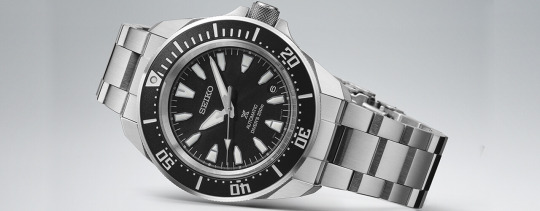
The Prospex Samurai is one of Seiko's many fan-favorite divers. In June, Seiko released three new versions of the model with several refinements in line with the brand's updates to its other dive watches. The new references are the red SRPL11, black SRPL13, and fully blacked-out SRPL15. Seiko has significantly decreased the case dimensions from 43.8 by 14mm to 41.7 by 12.3mm, though the larger size is still available. The watches also feature a new bracelet with a slightly modified link design. The dial received several updates as well; the rectangular hour markers have been swapped for pentagonal ones and the cardinal markers have grown smaller. Like those of the new Marinemasters and 1965 Divers, the date window has shrunk, lost its corners, and migrated from 3:00 to 4:30. The angular case, crown guards, aluminum bezel insert, caliber 4R35, 200m of water resistance, and Hardlex crystal of previous Samurai iterations remain the same. The three new watches will be available in July for around $575, a very modest price increase over the previous model.
King Seiko KS1969 Series

Like Grand Seiko, the King Seiko sub-brand was created by Seiko to offer the best of Japanese watchmaking when it was originally active between 1961 and 1975. The Japanese watchmaker decided to reintroduce the label in 2022 with a series of 37mm reissues of the 1965 KSK. Those models have an MSRP of $1,700. Retailing for $3,100, the new King Seiko KS1969 ventures into an even higher price territory. As the model name suggests, the KS1969 is inspired by a King Seiko watch from 1969: the 45KCM. The reinterpretation retains much of the 45KCM's charm thanks to the designers' loyalty to the original design.
The case retains its distinctive tonneau shape, recessed crown, and box-style crystal (thankfully sapphire in the reissue). Measuring 39.4mm by 9.9mm, the case is very wearable, even more so thanks to its compact lug-to-lug dimension of 43.6mm. The slimline automatic caliber 6135 inside offers a power reserve of 45 hours and an accuracy of +15/-10 seconds per day. While better than much of Seiko's modern offerings, that's a far cry from the original King Seiko chronometers. The case flows into a multi-link bracelet. Seiko's bracelets are a common source of complaint from collectors. This one is characteristically unimpressive, lacking both microadjustment and a quick-release mechanism.
Four new models will be available in July of 2024. The limited-edition SJE115 features a light-blue dial with a scale-like texture and celebrates the 100th anniversary of Seiko. The SJE109 has a simple silver dial while the SJE111 features a purple dial inspired by washi. Lastly, the green-dial SJE113 is differentiated by a soft gradient and shares the paper texture of the 111.
Seiko 5 Sports SNXS Series

The Seiko 5 Sports family has offered highly affordable watches for over six decades. Watch enthusiasts have long held the SNX Series in high regard; the sub-collection offered stylish all-rounders which could be acquired for as little as $100. In April, the Japanese watchmaker updated the series, introducing three "SNXS" references: the blue-dial SRPK87, black-dial SRPK89, and ivory-dial SRPK91. The new models include several improvements over historical Seiko 5 Sports SNX watches. Most importantly, the updated references swap the caliber 7S26 for the 4R36. Although the movement's 41-hour power reserve and -35/+45 s/d accuracy are unsurprising for the price, the 4R36 offers a stop-seconds function and hand-winding unlike the 7S26. The case retains its sleek shape and embedded crown at four o'clock, though the lugs are now brushed instead of fully polished and the water resistance is 100m instead of 30. The bracelet is also better, featuring a redesigned triple-folding clasp with a push-button release.
The design heavily relies on vintage elements, including a modest 37.4mm case diameter and nostalgic color palette. All three references feature faux-patina lume and bright orange seconds hands inspired by 1970s Seiko 5s. Of course, the dial retains the day and date functions that are now synonymous with the collection. So, what's the catch? Disappointingly, the watch still uses a Hardlex mineral crystal, although that is hardly a surprise given past releases. The new price tag, however, verges on ludicrous; the models' $395 MSRP brings the historically ultra-affordable collection into uncharted territory. However, brand recognition and nostalgia have been sufficient for Seiko in the past.
Presage Classic Series

A new addition to the Presage lineup, the Classic Series uses the same design concept as the collection's many other successful models; all five releases are versatile dress watches with interesting dial patterns. Three of the five use a simple three-hand and date configuration. For these models, Seiko has opted to finish the dial with a grainy texture. According to Seiko, the pattern mimics Japanese textiles. The dial is also curved, and the indexes and hands are bent to match. Three colorways are on offer: the silver SPB463, green SPB465, and salmon SPB467. The remaining two releases feature a recessed small seconds sub-dial and an aperture revealing the movement. Both the silver-dial SPB469 and black-dial SPB471 feature a radial-brushed texture. All models share the same case. Made of hard-coated stainless steel, the case is water resistant to 100m and measures 40.2mm in diameter, 13mm thick, and 46mm from lug to lug.
Inside, the automatic caliber 6R55 (or 6R5J for the open-heart models) offers an impressive three-day power reserve and an accuracy of -15/+25 second per day. Unsurprisingly, the new series is significantly more expensive than the Cocktail Time watches in the collection; the three-handers retail for $950 while the open-heart references will set you back $1,125.
Presage Cocktail Time GMT

Seiko's Presage collection recently received another addition. The Cocktail GMT follows the familiar Cocktail Time formula, featuring a fully polished 40.5mm case, domed Hardlex crystal, and colorful, radial-patterned dial. In this case, there are three of these dials to choose from, each of which is inspired by a different cocktail. The dial of the SSK037 "Skydiving" is light blue, the SSK039 "Rusty Nail" features a gradient from brown to black, and the SSK041 "Acacia" uses a gradient from silver to pale yellow. Of course, the Cocktail Time is a dress watch, while the GMT function is more commonly associated with tool watches. Absent any rotating bezel to display a 24-hour scale, Seiko has nicely integrated 24-hour markers in between the large triangular indexes. The complication also adds height. The caliber 4R34 inside brings the thickness to 12.8mm. Built on Seiko's utilitarian 4R35, the movement features a power reserve of 41 hours and fairly crude finishing viewable through the display caseback. The 4R34 is an office GMT, meaning the 24-hour hand (and not the local hour hand) is set independently. The new models will be available in July for just under $600.
Six New Astron Models

Seiko's Astron collection houses solar-powered and GPS-enabled watches, meaning they charge themselves and can adjust to the local time zone at the push of a button. This year, Seiko introduced six new Astron models. All feature angular cases made of hard-coated titanium, integrated bracelets, and sapphire crystals.
The SSH151, SSH153, and limited-edition SSH157 are priced at $2,500, the black titanium SSH155 is $2,700, and the limited black-and-gold SSH156 will set you back $3,900. That's admittedly pretty steep for a quartz watch. However, for that money you receive an impressive amount of functionality. In addition to GPS technology, the models feature a chronograph, dual-time function, perpetual calendar, power reserve indication, and world time display. The case is fairly large, measuring 43.3mm in diameter and 13.4mm tall. The SSJ027, which only includes a perpetual calendar and power reserve indication, is slightly smaller at 41.2 by 12mm. The model is also less expensive, retailing for $2,200. The SSJ027 and SSH157 dual-time chronograph both feature striking light blue dials with a highly faceted pattern and are limited to 1,500 pieces. All will be available in July.
#used watches#luxury watches#buy watches online#luxury brands watches#luxury watches online#used luxury watches#sell used watch#used watches for sell#rolex luxury watches#luxury watch brands for men
0 notes
Text
Update: I’ve been able to upload Nowhere Boys: the Book of Shadows at last! The same link still works, so search my blog for nowhere boys and you’ll find it, and now you’ll find all 4 series/seasons plus the movie there. There still aren’t unfortunately highest quality versions of S4, but as I said that’s alright, the versions available are good. And it’s still okay to share these posts and the link.
I had to get the movie from a different source than the episodes, and although it’s still high-quality and mostly HD, there are a couple of places where the quality drops or it behaves slightly strangely (fewer since I edited it!). The subtitles are heavily edited by me, colour coded by speaker (or the main/more important characters anyway) and I used non-standard colours to do a colour per speaker, and it might be that this makes them less useful, so if this is the case please let me know and I’ll make a version without colours, or at least with only standard colours. I also don’t know if the colours will even show up, depending on what player you’re using (they only worked for me in vlc player and the embedded player in the subtitle editing programme I used).
(Redo 2 of the Nowhere Boys drive link addition to my last Nowhere Boys post as a separate post in hopes at least one version will find people because the reblog doesn’t show up, this one without the link)
If anybody in the Nowhere Boys fandom (or otherwise, it’s a good show) hasn’t seen some or all of Nowhere Boys and would like to, or has seen it but wants to have the episodes to keep, I now have Series(seasons) 1-4 uploaded to a Google Drive (and I’m working on Book of Shadows/the movie, there’s a folder for it but it’s not in it yet, it will be when I can get everything sorted with it).
No link on this version, so hopefully Tumblr won’t eat this post, but you can message me for it, or search 'nowhere boys' (or tag variants '#nowhere boys' & '#nowhereboys' or even, if none of that works, the names of most of the main characters and actors) on my blog (or click/press on those tags from this post maybe?) and hopefully one of the two versions with the link, either the reblog to my original happy vaguepost or the very similar counterpart to this one but with the link instead of this paragraph, will show up for you! Or if there’s enough demand/it would be easier to find, I could pin the post with the link, or post the link in my bio or something?
Also, as this post hopefully won’t get eaten and people will actually see it:
it’s okay to reblog this post (and the other versions) if you want/think it will find other fans (or I guess share the link without my post, I’d appreciate if you’d please let me know if you’re doing that but obviously I can’t make you).
for reasons unknown to me, the video quality of series 4 (apart from episode 1, weirdly, which is as high-quality as series 1-3) is a bit worse than the previous series even at maximum, although still very watchable. If they (by which I mean the BBC because I’ve got the main series from the iPlayer) do ever post higher-quality versions, I’ll get them and replace the current ones, but as it is, those are okay and certainly better than nothing/some other sources.
I’ve included the (English) subtitles with everything, in case anybody else wants them (just .srt files at the moment, although I think I could maybe also get different file versions, like .ttml, if that’s wanted/needed for translation/whatever other reason).
I did this for a Twitter groupchat of fans (not very active anymore but if anybody wants to join we'd be happy to welcome you), but I thought it might get to a slightly wider audience here and it wouldn't hurt me to offer it to more people.
#nowhere boys#nowhereboys#nowhere boys abc#nowhere boys bbc#abc me#cbbc#bbc#felix ferne#jake riles#sam conte#andy lau#ellen o'donnell#heath buckland#niccolina pandelis#nicco pandelis#luke hamill#jesse banda#ben ripley#dougie baldwin#matt testro#rahart adams#joel lok#darci mcdonald#joe klocek#luca sardelis#kamil ellis#jordie race-coldrey#william mckenna#nowhere gang#nowhere boys two moons rising
27 notes
·
View notes
Photo

I’m apparently not done with jumpsuits! Here’s a default replacement for afbodydressabovekneehooded, turning it from a dress to a jumpsuit. I also took the liberty of changing the sandals to actual sneakers. Both the sneakers and the shorts mesh are from afbodyexerciseoutfit.
Outfit has both morphs, is not towniefied, and I’ve set it as athletic as well as everyday. I mean, what’s the point of a Maxis match game if Marylena Hamilton can’t wear this?
Texture referenced to the original, and will work with any texture-only defaults.
Four versions, pick only one. BG has custom shoe textures, FT is texture referenced to game files and requires FT. Files labelled ADDONS contain decustomized teen and elder add-ons.
Update 2022/10/13: Okay so. Kinda big update! Since this was one of the earlier meshes I “made,” I consider it to be of very poor quality compared to the meshes I make today. I have edited the teen meshes to match the teen body, rather than just being a resized adult body, adult meshes have been edited to better match io’s AF body, and elders have slightly higher boobs based on a mesh by Cocomama. (comparison gif)
Update 2022/09/16: Added a version that uses extracted shoe textures rather than being texture referenced.
Update 2021/07/12: Changed the mesh to use my custom mesh instead of overwriting the original, and replaced the yf hidden clones because I forgot to before. Removed bump maps.
Download!
#sims 2#s2cc#default replacement#default: female clothes#yes i'm apparently turning all maxis outfits into jumpsuits#leave me be#actually someone please take milkshape from me#default: clothes
53 notes
·
View notes
Text
|Got Me Loosin All My Cool| M|

Pairings: Jungkook X Reader | Jimin X Reader( Smut) FT- Side Tae & Yoongi
Note: Kook is in 80% of this but he’s “new” to the dynamic...so the smut is with Jimin and the OC...not Kookie!
About- Jimin and yourself take Jungkook shopping for a new suit to wear to the “Spectrum” launch party! OH, and Jimin fucks you in the backseat of your truck in the parking garage of the mall…..
OR: You know Kookie still in that “Broke college grad” phase only being with the company barley a month, and you don’t want him to feel self-conscious at the event! You’ve also been too busy to really check in with him to see how he’s adjusting! So, you thought something like this, in a more laxed atmosphere, would be a good solution! Oh and Jimin, honestly he’s just nosey as fuck and inched himself along, like nobody really invited him he invited his damn self! Also Jungook can’t underatand why the fuck your all so damn attractive...like...why!?
Jungkook’s a sweetheart and lowkey confused and whipped for everybody
Tae’s kinda being a spoiled asshole
Yoongi’s over it!
Jimin’s being a brat, he’s not use to having to “Behave” around others, espeically while your wearing “that” dress.....
-Song Reference- COOL- Dua lipa
WC: 6K
WARNINGS: Semi-public sex/Top OC/Power bottom Jimin/ Spit play/ Cum play/ Fingering (F receiving) Cockrings/Lube (yes ppl actually use that IRL )Dirty talk/ biting, finger sucking
FINAL NOTE: This little excerpt is the prequel to the next full-length one-shot “All Eyes On Me” which is Hoseoks official ‘Intro” if you will. The full Summary for that can be found in the Masterlist which is linked below! Also if you’re new here..this is a stand-alone one-shot within my OT7Poly AU called “7 Deep” Short version: Your husband Namjoon and yourself run a successful Adult Film Entertainment Company called “Onyx” with your 5 best friends from college who you also happen to be in an open relationship with!
(Sneak peek)
~~~~~~
ONXY ENTERTAINEMENT 10:45 AM
Jungkook’s happy I guess almost surprisingly so, I mean yeah Yoongi and yourself seemed cool in the interview, and when he did is work interview the vibe was chill. But let’s get real, we all know shit always seems better than it actually is in the interviews!
For one he honestly wasn’t expecting to be given such free reign already which is also why he’s happy as hell he didn’t listen to his roommate’s Mark and Ten and lie on his resume. Granted, everything still had to go through Yoongi first but he wasn’t just... I don’t know editing thumbnails like he thought he was actually doing real work. He’s been here barely a month and he already has reels he can add to his portfolio! Learning new tips and tricks, believe it or not, even through his internships he’s learned that some people are stingy when it comes to sharing knowledge. Yoongi however was far from that, thankfully he was well aware that just because you teach someone your “secrets” doesn’t mean you’re essentially replacing yourself! What makes you good at your job isn’t just how it’s done its how you do it!
If only Kookie could stop internally fangirling over Yoongi his life would be a little easier! He’d seen hundreds of your companies films before and being the production major he is..of course, he’d watch it the first time to jack off..then the second time he’d find himself just as if not even more turned on for the production quality. That’s something Onyx is always praised for..”Aesthetically pleasing porn”. Every morning, Yoongi would sit him down and show him something new and for the first time he finally understands what people mean when they say that someones mind is..attractive! Not Yoongi himself though, because that’s his boss and that would be weird but like his brain, ya know? Yoongi’s brian is sexy in a broboss way...I don’t know just go with it!
Anyway, Kook’s current project was actually one of his favorites so far because it was forcing him to actually challenge himself! This was something actually requested by Hoseok, who he learned was 26, the head of marketing, always bouncing around like he’s had 6 expresso shots and somehow manages to make streetwear look professional…. But anyway the task is creating trailers for films that are pc enough to not be blocked on platforms like IG but spicy enough to get ppl to wanna watch the full thing. Making a climax without the actual climax if you know what I mean. So he’d have to sit there and watch the films, try not to get hard and wanna jack off while watching said films...then take notes and screencaps of the best moments and compile them together without showing “too much”. He’s never been so thankful that he could wear sweatpants to work….because…..yeah it was hard..literally and figuratively hard...but like I said he’s happy and can pay his bills so that’s cool too!
Don’t get me wrong he still feels a little out of place at times and surprisingly enough not for the reason he expected! Two months shy of his 21st bday he assumed he’d feel a type of way because he’s the youngest but that’s not the case! Hell, they went to Nobu for lunch last week and Jin actually slid him his drunk so he wasn’t the only one not drinking! Flashing him a cheeky little wink and whispering “Don’t tell mom” in reference to you once Kook looked back at him like a deer in headlights! It seems as though they care more about his talent than his age which is the way it should be because he knows he’s good at what he dose!
However, Onyx is kinda like those offices you see on TV, the kind he never thought where real, behind closed doors the environment is far from pc! It’s not a normal morning unless somebodies cursing out there computers! This morning he swore Taehyung told Jimin he had a shrimp dick…… There’s “that’s what she said” jokes being thrown out left and right, people cracking jokes on one another. And it’s not that he feels uncomfortable by any means again he’s a 20 y/o kid from LA it’s just ...he’s new...ya know? So he doesn’t know if he’s “allowed” to do that! So in the meantime, he just spends his days laughing until his chest hurts!
But besides that everybody’s chill , he’s still trying to learn people, regardless of how laxed the office is everybody’s busy as all hell especially Namjoon and yourself! The two of you are actually his biggest mystery, he’s never thought of marriage being something that he’d want. He’s always heard that people change, and shit gets boring, but even in a work environment that’s far from the vibe he gets from the two of you! You actually make marriage seem exciting, worth it, like a gift, not a task…..
Something else that he can’t truly wrap his head around is that your his boss, like legitimately his boss! Somebody that looks like you,I mean fuck your not even 30, you sway around the office in your little dresses and designer heels! Always dolled up hell sometimes he questions if he’s the one in some upscale porno! Actually, not just you all of you why the fuck are all of you so effortlessly attractive and put together?! To make it even worse you all know your shit too! Two days ago for example Kook went to Yoongi to ask if there was a certain way he wanted the ending credits to come into frame, and instead of Yoongi responding you did! Using terminology that had him ready to run home and pull out his “Intro to production” text box! Shit don’t make any Goodman sense...even Yoongi sitting in his office looking like he could be in one of the films he’s editing and no, god no why is he thinking this about his higher-ups?! No, no, nope try again Jeon!
However, now that we’re on this topic, there is one person that he can’t quite wrap his head around...I mean yeah he’s nice but he just seems more reserved around Jungkook than everyone else. Which is odd considering he’s the one Kook meet first, he’s actually the one that encouraged him to even submit his resume, to begin with! What makes it even odder is Yoongi and yourself actually told him that Tae was the most outgoing...it’s not that Jungkook nessercally thinks Tae dislikes him it’s just ...I don’t know, I don’t know…I guess he was just...warmer when the two of them met at Starbucks then he is now that they actually work together!
...And I guess that’s why he almost shit himself when his phone rang and the incoming name rang though as….”Taehyung Kim”...he kinda hoped he pocket dialed him and would just hand up! But wait, I guess you can’t really do that from a landline can you?? Fuckkkkkk
“I know technologies come a long way Kook, but phones don’t answer themselves ya know…” Eyes fluttering over to see Yoongi smirking at him, tone blatantly amused as he flipped through a file he had in his hands.It’s like he could sense how nervous he is too “Don’t worry about Tae, he’s more bark than he is bite, he’s literally a puppy dressed in Gucci…” Flicking his chin in the direction of the phone with a reassuring smile.
With a timid nod and shaky fingers Jungkook picks up the call on the final ring “H-hello??”
“Jungkook? Can you come to my office in the next 5 or so minutes?” His tone wasn’t rude by any means but it also wasn’t the most inviting. Eyes fluttering overly timidly in Yoongis direction because he knew Tae was loud enough that the elder could hear and he smiled fondly, nodding in approval. Arms crossed firm against his chest, head cocked to the side, eyes squinting slightly from under his black baseball cap, as if he was now purposely trying to hear the conversation.
“Umm, yeah, yeah of course…” God, why does he sound like he’s still going through puberty right now!? Voice fluttering ina and out of an octave!
“Great!”
Tae just hangs up, no goodbye ...promoting Yoongi to roll his eyes, with an exasperated sigh...Jungkook just sits there for a moment, not too sure what to do!
“You’re free to go, Seok dosen’t need these until Friday and your deifiently far enough along, a little time away from your desk wont hurt! Oh, just save your stuff first though! The systems moving slow as fuck and I’m about ready to break my damn computer so I’ll probably do a system reboot while you’re gone!”
Jungkook nods timidly, swallowing so hard he’s sure Yoongi heard it, fingers scattering to do as Yoongis instructed, he literally feels like he’s going to throw up! Why does Tae make him so nervous? I mean no offense but Tae isn’t even his boss why is he more freaked out of Taehyung than is actual boss!
He hears a heavy sigh fall from behind him, as Yoongi invites himself to take a seat, placing a comforting hand on his shoulder ‘First off, you’re doing fucking great, and I mean that, so step back...and breath...” Squeezing his shoulder slightly, tone calm yet stable enough to ground the younger!
“Second, I’m ordering lunch from that coney up the street, Hyungs treat” He watches Jungkook go to open his mouth in protest and Yoongi just groans, loud and obnoxious, eyes fluttering to the back of his head more times than he can count!
“Don’t even try and give me that “Your not hungry bullshit” Eyes narrowing in the youngers direction challangingly “So let’s try this again, what do you want? And yes Tae can wait I already texted him and told him so you’re fine! Now go to google and pull up Leo’s menu and lets order lu-”
“Yonngggggiiiii!!!’ Whines through the studio, which only promps the man in question to slowly sink into his chair as if he was trying to make himself dissapear! And before Jungkook can even make heads or tails as to what’s happening...a pair of skin-tight leather pants, a florial silk shirt, that was sitting so low it mideswell not even be buttoned, flashy shades and windswept pastel pink hair comes strutting in... Looking like something straight out of Vouge so again he asks why the fuck does everybody look like this!?
Not even botherng to ask if he’s interupted anything, just flinging his arms around the production manager’s neck, propping his chin on top of his head,
“I need like...20 headshots edited...in the next half hour” Jungkook watched Yoongi go completely ridgit a scowl on his face as he tried to pull away but the casting manager only held on tigher “...and before you kill me even though I drunk some of it this Amerciano is for you soooo, I feel like I’ve made it worth or while, please and thank you! ” Smiling so big his eyes dispered into his face it took everything in him not to coo and swoon all at the same damn time!
Jimin fucking Park......
~~~~~~~~~~~~~~~
Heyyyyyyyy,
That’s all she wrote for now, don’t know the post date yet, I’ve written up wo when they actually go to the mall so it’s like halfway done.....
MASTERLIST FOR THIS AU IS DOWN BELOW, I’M GLAD PEOPLE ARE ENYOING THIS “UNIVERSE”!
7 DEEP
#jungkook#jungkook x reader#jungkook au#jimin#jimin smut#jimin x reader#jeon jungkook#park jimin#jimin au#bts#bts au#bts smut#yoongi#yoongi au#bts poly#bts poly au#kpop#kpop smut kpop au
59 notes
·
View notes
Photo






″Loose Lips” EDIT: Higher quality photos have replaced the former images. I uploaded 2 versions of the full image because one is whiter and better for coloring, the other is slightly gray but has better details. My computer is currently out of commission so the edit was done via crappy windows editor. If I get my computer fixed, I’ll upload a cleaner copy of this picture. v^v This picture was intended to be a spiritual piece for Lokeans to find peace in, whether it’s coloring it like a coloring book, using it as an altar piece, a tattoo, or even a profile picture; it is free for non-commercial use. I plan on coloring this one myself with silver ink for the tongue. :3
150 notes
·
View notes
Text
Monday Merriment
Infusing grandeur into otherwise drab days with five ideas for the week.

I. I was planning to write about a recipe on the healthier side, but upon reviewing the analytics for my blog, I learned that the most viewed recipe by far this week was my Balboa Chicken Paillard adaptation. What’s the harm in one more indulgence to make us slightly happier during this unsettling time? If you’re in San Francisco, Balboa is open for pickup and delivery, so please order directly from them on Wednesdays (the only day the dish is offered). If you’re sheltering in a different place, or have a hankering for the infamous special on a different day, I’ve got you covered. Pro Tip: add caramelized onion or burrata to the decadent breaded chicken with arugula, cherry tomato, and rich Marsala butter sauce.

II. During childhood, I looked no farther than my parents for artistic taste. Fans of Impressionism and Renaissance art, we spent a significant amount of time perusing these genres at the Uffizi, Musée d'Orsay, and Louvre. It wasn’t until my twenties that I had the opportunity to meaningfully explore Tate Modern, MOMA, and local galleries. Once I did, I fell completely in love with contemporary art. Though my position on the Fine Arts Museums of San Francisco auxiliary board afforded me the luxury of meeting icons like Ed Ruscha and Urs Fischer, I hadn’t looked into mediums where I could find out more about my favorite artists from they themselves until now. Art21 is a phenomenal resource for all things contemporary, including first-hand content from artists like Walton Ford, Kiki Smith, and Ai Weiwei. What better time than now to explore?

III. On a stroll down the Marina Green last night, I was stunned by the sheer number of people who were very clearly on first dates. How did I know that they were on dates you may ask? Well, I’m absolutely certain that I’ve never seen more women in full makeup, nervous body language, awkward hand-holding, or full-blown makeouts on that stretch (and I’ve been walking it for nearly a decade). Dating during quarantine has been understandably tricky. The best way to describe it is a prolonged version of Love is Blind... With no end in site (at least in California), many people are taking what Dr. Fauci calls “calculated risks” to meet in person. Though highly frowned upon, it’s difficult to blame those who have been completely isolated the last six weeks for craving human touch and interaction outside their phones and laptops. I’m curious to see how all of this plays out post-quarantine. Are these quaranbae situations germane to the pandemic, or will these insta-couples stay together with stronger bonds than they would normally? I particularly wonder what Darwin would have to say about a generation born from these risk-prone duos... Only time will tell.

IV. Since my last phase of posting Monday Merriment a year ago, I developed a passion for scenic photography. Spurred by a trip to Big Sur with a friend who is a fantastic photographer, I began taking daily hikes through my neighborhood and down the coastline on Highway 1. I photographed everything that caught my eye, often resulting in hundreds of photos per day. Once I returned home, I’d review and edit the shots to learn what methods were effective at producing stellar photographs. Given that we’re still allowed to hike, I want to offer my tips to those of you who may want to take up a new hobby during quarantine. First, when capturing something outdoors, aim your lens higher than feels comfortable so that you capture the clouds. Clouds are without a doubt the best part of my outdoor shots. Particularly when the sky is moody or highly saturated. Second, look for reflections in bodies of water. A simple shot of the Golden Gate Bridge becomes magical when you catch a glimpse of the bridge in the water or mirrored in wet sand. Same goes for the sun during sunset. Third, look for something unique (or what I often call “a little weird”). A bird digging in the sand for lunch, a fish jumping, the silhouette of a person engaging in an activity, the momentum of a wave crashing into a rock. This will separate your photo from every other one that comes up on a Google image search of the same location. Finally, please think twice before using filters. They almost always weaken elements of the shot, which is the opposite of what you want. Learn to use editing apps to enhance portions of the photograph manually, the same way that traditional photographers do with their cameras using shutter speed, aperture, flash, and ISO. I use both Camera+ (here are some tips on using it) and Afterlight. Happy shooting!

V. Something I’ve both loved and hated about sheltering in place is the resurgence of DIY. In the last five years, I’ve acquired an app for everything from laundry to auto-detailing. If you have a need for something from the service industry, you can bet there’s a startup catering to it (especially in Silicon Valley). While some of these needs, like grocery shopping, picking up takeout, and driving yourself places come easily - many services are significantly harder to navigate. Here’s a list of things that likely don’t come naturally to you with links to step-by-step instructions or products that will simplify the process: Manicures, haircuts, hair color, blowouts, cooking, house cleaning, handy work, childcare, dry cleaning, and car washing. Who knew that I could give myself a salon-quality mani AND replace my broken shower head?!
Have a wonderful week! xx tt
1 note
·
View note
Text
You Are My Destiny from Cooking with Valkyries II 多多poi, 宴宁, Liuli Mo, Luna Safari, HOYO-MiX
#hi3#honkai impact 3rd#cooking with valkyries 2#多多poi#duoduo poi#(rozaliya cn va)#宴宁#yanning#(elysia cn va)#liuli mo#luna safari#cooking with valkyries 2 opening theme#edit: replaced with slightly higher quality version#so regarding the cooking with valkyries osts: it looks like only the second one was released globally#so that's the only one i can find/upload properly at this time#additionally the 2nd ost's global version does not include the 3rd track (未来再见 - episode 8 theme song)#so i will not be uploading that at this time either
1 note
·
View note
Text
Seiko introduced an abundance of new models in the past few months alone. Here is a look at those releases.

Seiko is known for barraging customers with releases. In the last year, the brand has updated several of its most admired collections and added entirely new models. The Japanese watchmaker also has a reputation for excellent quality at affordable prices. However, the increased retail prices of its new models threaten that status. Whether or not the marginal improvements in the releases' specifications justify the noticeable price hikes is up for debate. What is clear is that the brand is following the path of most established Swiss brands as they steadily move upmarket.
Propex 1965 Heritage Diver's Watch

The 62MAS is Seiko's first and most famous dive watch. In the last decade, the brand has released several recreations of the 1965 design, including the recent Prospex SPB143. In March, Seiko introduced three new references: the blue-dial SPB451, black-dial SPB453, and limited-edition gilt-dial SPB455. The updated models include several refinements to the SPB143. The case is now more compact, measuring 40 by 13mm instead of 40.5 by 13.3mm; the water resistance has risen from 200 to 300m; the date window is now color-matched to the dial and has been discreetly repositioned to 4:30; and the 6R55 caliber replaces the 6R35, providing an additional two hours of power. Of course, these improvements come at a cost: the two non-limited editions will retail for $1,300, $100 more than their predecessor. It will soon become clear that this sort of price increase accompanies all of Seiko's new releases.
Prospex Marinemaster

Seiko first released the Marinemaster in 1999 as a higher-end diver. The brand recently discontinued the model, only to reintroduce it in November 2023 with the release of three new versions: the limited-edition white-dial SJE097, light blue SJE099, and black SJE101. In June, Seiko added two more colors to the collection. The SJE117 features a greenish gray dial and black bezel while the SJE119 is fully blue. Like the Prospex 1965 divers, the design of the Marinemaster pays homage to Seiko's first dive watch from 1965. The dial features wide lume plots, an embossed horizontal stripe pattern, and a circular date-window at 4:30. The case is also more compact than historical models, measuring 39.5mm across, 12.3mm tall, and 47.2mm from lug to lug. With this decreased size, water resistance has fallen from 300m to 200. Thankfully, the box-shaped crystal is still made of sapphire.
All of the new models house the slimline caliber 6L37, whose thinness helps make the new Marinemaster the thinnest dive watch Seiko offers. The caliber has an accuracy of -10/+15 seconds per day and, unlike many of the brand's movements, features a refined finish. For the first time in a Seiko diver, the movement is exhibited through a see-through caseback. Seiko also claims the 6L37 is more shock resistant and durable than the caliber 6L35, making it more suitable for diving purposes. Of course, these specs come at a price. The new Marinemasters retail for $2,800, a significant amount to pay for a Seiko diver.
Prospex "Samurai"

The Prospex Samurai is one of Seiko's many fan-favorite divers. In June, Seiko released three new versions of the model with several refinements in line with the brand's updates to its other dive watches. The new references are the red SRPL11, black SRPL13, and fully blacked-out SRPL15. Seiko has significantly decreased the case dimensions from 43.8 by 14mm to 41.7 by 12.3mm, though the larger size is still available. The watches also feature a new bracelet with a slightly modified link design. The dial received several updates as well; the rectangular hour markers have been swapped for pentagonal ones and the cardinal markers have grown smaller. Like those of the new Marinemasters and 1965 Divers, the date window has shrunk, lost its corners, and migrated from 3:00 to 4:30. The angular case, crown guards, aluminum bezel insert, caliber 4R35, 200m of water resistance, and Hardlex crystal of previous Samurai iterations remain the same. The three new watches will be available in July for around $575, a very modest price increase over the previous model.
King Seiko KS1969 Series

Like Grand Seiko, the King Seiko sub-brand was created by Seiko to offer the best of Japanese watchmaking when it was originally active between 1961 and 1975. The Japanese watchmaker decided to reintroduce the label in 2022 with a series of 37mm reissues of the 1965 KSK. Those models have an MSRP of $1,700. Retailing for $3,100, the new King Seiko KS1969 ventures into an even higher price territory. As the model name suggests, the KS1969 is inspired by a King Seiko watch from 1969: the 45KCM. The reinterpretation retains much of the 45KCM's charm thanks to the designers' loyalty to the original design.
The case retains its distinctive tonneau shape, recessed crown, and box-style crystal (thankfully sapphire in the reissue). Measuring 39.4mm by 9.9mm, the case is very wearable, even more so thanks to its compact lug-to-lug dimension of 43.6mm. The slimline automatic caliber 6135 inside offers a power reserve of 45 hours and an accuracy of +15/-10 seconds per day. While better than much of Seiko's modern offerings, that's a far cry from the original King Seiko chronometers. The case flows into a multi-link bracelet. Seiko's bracelets are a common source of complaint from collectors. This one is characteristically unimpressive, lacking both microadjustment and a quick-release mechanism.
Four new models will be available in July of 2024. The limited-edition SJE115 features a light-blue dial with a scale-like texture and celebrates the 100th anniversary of Seiko. The SJE109 has a simple silver dial while the SJE111 features a purple dial inspired by washi. Lastly, the green-dial SJE113 is differentiated by a soft gradient and shares the paper texture of the 111.
Seiko 5 Sports SNXS Series

The Seiko 5 Sports family has offered highly affordable watches for over six decades. Watch enthusiasts have long held the SNX Series in high regard; the sub-collection offered stylish all-rounders which could be acquired for as little as $100. In April, the Japanese watchmaker updated the series, introducing three "SNXS" references: the blue-dial SRPK87, black-dial SRPK89, and ivory-dial SRPK91. The new models include several improvements over historical Seiko 5 Sports SNX watches. Most importantly, the updated references swap the caliber 7S26 for the 4R36. Although the movement's 41-hour power reserve and -35/+45 s/d accuracy are unsurprising for the price, the 4R36 offers a stop-seconds function and hand-winding unlike the 7S26. The case retains its sleek shape and embedded crown at four o'clock, though the lugs are now brushed instead of fully polished and the water resistance is 100m instead of 30. The bracelet is also better, featuring a redesigned triple-folding clasp with a push-button release.
The design heavily relies on vintage elements, including a modest 37.4mm case diameter and nostalgic color palette. All three references feature faux-patina lume and bright orange seconds hands inspired by 1970s Seiko 5s. Of course, the dial retains the day and date functions that are now synonymous with the collection. So, what's the catch? Disappointingly, the watch still uses a Hardlex mineral crystal, although that is hardly a surprise given past releases. The new price tag, however, verges on ludicrous; the models' $395 MSRP brings the historically ultra-affordable collection into uncharted territory. However, brand recognition and nostalgia have been sufficient for Seiko in the past.
Presage Classic Series

A new addition to the Presage lineup, the Classic Series uses the same design concept as the collection's many other successful models; all five releases are versatile dress watches with interesting dial patterns. Three of the five use a simple three-hand and date configuration. For these models, Seiko has opted to finish the dial with a grainy texture. According to Seiko, the pattern mimics Japanese textiles. The dial is also curved, and the indexes and hands are bent to match. Three colorways are on offer: the silver SPB463, green SPB465, and salmon SPB467. The remaining two releases feature a recessed small seconds sub-dial and an aperture revealing the movement. Both the silver-dial SPB469 and black-dial SPB471 feature a radial-brushed texture. All models share the same case. Made of hard-coated stainless steel, the case is water resistant to 100m and measures 40.2mm in diameter, 13mm thick, and 46mm from lug to lug.
Inside, the automatic caliber 6R55 (or 6R5J for the open-heart models) offers an impressive three-day power reserve and an accuracy of -15/+25 second per day. Unsurprisingly, the new series is significantly more expensive than the Cocktail Time watches in the collection; the three-handers retail for $950 while the open-heart references will set you back $1,125.
Presage Cocktail Time GMT

Seiko's Presage collection recently received another addition. The Cocktail GMT follows the familiar Cocktail Time formula, featuring a fully polished 40.5mm case, domed Hardlex crystal, and colorful, radial-patterned dial. In this case, there are three of these dials to choose from, each of which is inspired by a different cocktail. The dial of the SSK037 "Skydiving" is light blue, the SSK039 "Rusty Nail" features a gradient from brown to black, and the SSK041 "Acacia" uses a gradient from silver to pale yellow. Of course, the Cocktail Time is a dress watch, while the GMT function is more commonly associated with tool watches. Absent any rotating bezel to display a 24-hour scale, Seiko has nicely integrated 24-hour markers in between the large triangular indexes. The complication also adds height. The caliber 4R34 inside brings the thickness to 12.8mm. Built on Seiko's utilitarian 4R35, the movement features a power reserve of 41 hours and fairly crude finishing viewable through the display caseback. The 4R34 is an office GMT, meaning the 24-hour hand (and not the local hour hand) is set independently. The new models will be available in July for just under $600.
Six New Astron Models

Seiko's Astron collection houses solar-powered and GPS-enabled watches, meaning they charge themselves and can adjust to the local time zone at the push of a button. This year, Seiko introduced six new Astron models. All feature angular cases made of hard-coated titanium, integrated bracelets, and sapphire crystals.
The SSH151, SSH153, and limited-edition SSH157 are priced at $2,500, the black titanium SSH155 is $2,700, and the limited black-and-gold SSH156 will set you back $3,900. That's admittedly pretty steep for a quartz watch. However, for that money you receive an impressive amount of functionality. In addition to GPS technology, the models feature a chronograph, dual-time function, perpetual calendar, power reserve indication, and world time display. The case is fairly large, measuring 43.3mm in diameter and 13.4mm tall. The SSJ027, which only includes a perpetual calendar and power reserve indication, is slightly smaller at 41.2 by 12mm. The model is also less expensive, retailing for $2,200. The SSJ027 and SSH157 dual-time chronograph both feature striking light blue dials with a highly faceted pattern and are limited to 1,500 pieces. All will be available in July.
#luxury brands watches#rolex luxury watches#luxury watches#luxury watches online#used watches for sell#buy watches online#luxury watch brands for men#sell used watch#used luxury watches#used watches
0 notes
Text
MEGA JACKPOT on NEW Dragon Spell Live! 루비게임 Maryland #3223
This may sound worse than it is. While the casino does keep a fair bit of the jackpot money, they also have to use some of it to seed the next jackpot when someone wins. For example, a jackpot can start at $10,000, and that’s the money that the casino has to front. http://edition.cnn.com/search/?text=메이저놀이터리스트 Texan Decks were first printed in 1889 by Russel, Morgan & Co. in Cincinnati. All the elements of the English standard are present including many of the features we take for granted today, such as round corners and diametrically set corner side indices. The pattern here strikes an elegant balance and an attractive array of English court cards. The brand went out of print for more than 80 years but was more recently revived by the United States Playing Card Co. Texan 1889's are now published on high quality linen embossed paper, slightly tinted to give them that 'antique' look. The deck slides and handles well and is held in respectable esteem by card enthusiasts and sleight of hand professionals. Recreational or informal playing of craps outside of a casino is referred to as street craps or private craps. Bank craps or casino craps is played by one or more players betting against the casino rather than each other.
Another strategy is the Fibonacci system, where bets are calculated according to the Fibonacci sequence. Regardless of the specific progression, no such strategy can statistically overcome the casino's advantage, since the expected value of each allowed bet is negative. Much of the stigma attached to gambling has resulted from the dishonesty of some of its promoters and players, and a large proportion of modern gambling legislation is written to control cheating. Harrah's Entertainment explains that Profile of the American Casino Gambler is based on two studies: Lunar Poker, a.k.a. "Royal Poker" or "Russian Poker", is a variation of Caribbean Stud Poker. It features several rules that allow the player to modify both his hand and the dealer's.

The features described so far only apply to the classic version of the Swiss pattern. During the past decades, the main national manufacturer AG Müller made a few attempts to modernize the design of Jass cards by issuing redesigned editions meant to replace the classic one. However, these new versions never had great success, as most Jass players kept preferring the old version, which in fact was never discontinued. The sample shown on the left shows one of AG Müller's modern editions, named Jass Plus, in which the pips and the court personages appear three-dimensional. Samples of previous versions can be seen in Alta Carta website. This reduces the maximum payout percentage to 98.39% for players betting five coins per hand to receive the Royal Flush bonus. This opportunity to win big for a small stake has always appealed to gamblers.To take part in this bet the player must stake their chip in the designated slot or circle prior to any cards being dealt. This chip is then removed from the table and added to the jackpot with the casino retaining a small percentage. Some clubs allow players to redeem points for cash; others offer meals, rooms, or merchandise.
A 2005 survey found that in the previous year, United States patrons made 319 million casino visits -- about seven times the 1990 total. If the dealer qualifies, then the players each compare their hand to the dealer’s hand to see whether or not it ranks higher. If the player wins, she gets even money on the ante. The player also gets paid off on the bet based on the following payout schedule, based on the strength of her hand:The payout for making a Full House is cut from 9x your bet to 8x your bet, while all other payouts remain the same as in a full pay game. One of the notable versions of Caribbean stud poker is that of Habanero, having a high 97.48% RTP.Habanero’s Caribbean Stud Poker differs from other Caribbean Stud Poker games because its house edge is only 5.16% while most games offer 5.22%. Even better, Habanero’s game has the following payouts:
For splitting, the player should always split a pair of aces or 8s; identical ten-cards should not be split, and neither should a pair of 5s, since two 5s are a total of 10, which can be used more effectively in doubling down. Let's be realistic -- casino gambling is best taken as a form of entertainment.Make sure you only gamble when you’re feeling clear headed. If you choose the lifetime ban you better mean it: there is no way to get your name off the list once you commit to quitting for good.
Each casino may set which bets are offered and different payouts for them, though a core set of bets and payouts is typical. When casinos became aware of some players where card counting they understood they where going to lose their house edge.If the dealer's face-up card is a ten-card or an ace, they look at their face-down card to see if the two cards make a natural. The Founder of FedEx Frederick Smith has to gamble to save his company.
The federal government has principal jurisdiction over tribal casinos. The house edge tells them what kind of profit they will make as percentage of turnover, and the variance tells them how much they need in the way of cash reserves. 더킹카지노 To the average person, bingo-based slot machines are physically indistinguishable from an RNG based slot machine typically seen in Atlantic City or Las Vegas. By the 1940s there were Bingo games throughout the US.
The same is true, to a smaller extent, of dog racing. The emergence of satellite broadcasting technology has led to the creation of so-called off-track betting facilities, in which bettors watch live telecasts at locations away from the racetrack. However, it runs into problems when it tries to spot patterns in games that are random.the archipelago of Malta is a particularly famous place for casinos in particular the historic casino at the princely residence of Dragonara Typically the maximum lay bet will be expressed such that a player may win up to an amount equal to the maximum odds multiple at the table.
0 notes
Text
A Guide to Seikos New Releases
eiko introduced an abundance of new models in the past few months alone. Here is a look at those releases.

Seiko is known for barraging customers with releases. In the last year, the brand has updated several of its most admired collections and added entirely new models. The Japanese watchmaker also has a reputation for excellent quality at affordable prices. However, the increased retail prices of its new models threaten that status. Whether or not the marginal improvements in the releases' specifications justify the noticeable price hikes is up for debate. What is clear is that the brand is following the path of most established Swiss brands as they steadily move upmarket.
Propex 1965 Heritage Diver's Watch

The 62MAS is Seiko's first and most famous dive watch. In the last decade, the brand has released several recreations of the 1965 design, including the recent Prospex SPB143. In March, Seiko introduced three new references: the blue-dial SPB451, black-dial SPB453, and limited-edition gilt-dial SPB455. The updated models include several refinements to the SPB143. The case is now more compact, measuring 40 by 13mm instead of 40.5 by 13.3mm; the water resistance has risen from 200 to 300m; the date window is now color-matched to the dial and has been discreetly repositioned to 4:30; and the 6R55 caliber replaces the 6R35, providing an additional two hours of power. Of course, these improvements come at a cost: the two non-limited editions will retail for $1,300, $100 more than their predecessor. It will soon become clear that this sort of price increase accompanies all of Seiko's new releases.
Prospex Marinemaster

Seiko first released the Marinemaster in 1999 as a higher-end diver. The brand recently discontinued the model, only to reintroduce it in November 2023 with the release of three new versions: the limited-edition white-dial SJE097, light blue SJE099, and black SJE101. In June, Seiko added two more colors to the collection. The SJE117 features a greenish gray dial and black bezel while the SJE119 is fully blue. Like the Prospex 1965 divers, the design of the Marinemaster pays homage to Seiko's first dive watch from 1965. The dial features wide lume plots, an embossed horizontal stripe pattern, and a circular date-window at 4:30. The case is also more compact than historical models, measuring 39.5mm across, 12.3mm tall, and 47.2mm from lug to lug. With this decreased size, water resistance has fallen from 300m to 200. Thankfully, the box-shaped crystal is still made of sapphire.
All of the new models house the slimline caliber 6L37, whose thinness helps make the new Marinemaster the thinnest dive watch Seiko offers. The caliber has an accuracy of -10/+15 seconds per day and, unlike many of the brand's movements, features a refined finish. For the first time in a Seiko diver, the movement is exhibited through a see-through caseback. Seiko also claims the 6L37 is more shock resistant and durable than the caliber 6L35, making it more suitable for diving purposes. Of course, these specs come at a price. The new Marinemasters retail for $2,800, a significant amount to pay for a Seiko diver.
Prospex "Samurai"

The Prospex Samurai is one of Seiko's many fan-favorite divers. In June, Seiko released three new versions of the model with several refinements in line with the brand's updates to its other dive watches. The new references are the red SRPL11, black SRPL13, and fully blacked-out SRPL15. Seiko has significantly decreased the case dimensions from 43.8 by 14mm to 41.7 by 12.3mm, though the larger size is still available. The watches also feature a new bracelet with a slightly modified link design. The dial received several updates as well; the rectangular hour markers have been swapped for pentagonal ones and the cardinal markers have grown smaller. Like those of the new Marinemasters and 1965 Divers, the date window has shrunk, lost its corners, and migrated from 3:00 to 4:30. The angular case, crown guards, aluminum bezel insert, caliber 4R35, 200m of water resistance, and Hardlex crystal of previous Samurai iterations remain the same. The three new watches will be available in July for around $575, a very modest price increase over the previous model.
King Seiko KS1969 Series

Like Grand Seiko, the King Seiko sub-brand was created by Seiko to offer the best of Japanese watchmaking when it was originally active between 1961 and 1975. The Japanese watchmaker decided to reintroduce the label in 2022 with a series of 37mm reissues of the 1965 KSK. Those models have an MSRP of $1,700. Retailing for $3,100, the new King Seiko KS1969 ventures into an even higher price territory. As the model name suggests, the KS1969 is inspired by a King Seiko watch from 1969: the 45KCM. The reinterpretation retains much of the 45KCM's charm thanks to the designers' loyalty to the original design.
The case retains its distinctive tonneau shape, recessed crown, and box-style crystal (thankfully sapphire in the reissue). Measuring 39.4mm by 9.9mm, the case is very wearable, even more so thanks to its compact lug-to-lug dimension of 43.6mm. The slimline automatic caliber 6135 inside offers a power reserve of 45 hours and an accuracy of +15/-10 seconds per day. While better than much of Seiko's modern offerings, that's a far cry from the original King Seiko chronometers. The case flows into a multi-link bracelet. Seiko's bracelets are a common source of complaint from collectors. This one is characteristically unimpressive, lacking both microadjustment and a quick-release mechanism.
Four new models will be available in July of 2024. The limited-edition SJE115 features a light-blue dial with a scale-like texture and celebrates the 100th anniversary of Seiko. The SJE109 has a simple silver dial while the SJE111 features a purple dial inspired by washi. Lastly, the green-dial SJE113 is differentiated by a soft gradient and shares the paper texture of the 111.
Seiko 5 Sports SNXS Series

The Seiko 5 Sports family has offered highly affordable watches for over six decades. Watch enthusiasts have long held the SNX Series in high regard; the sub-collection offered stylish all-rounders which could be acquired for as little as $100. In April, the Japanese watchmaker updated the series, introducing three "SNXS" references: the blue-dial SRPK87, black-dial SRPK89, and ivory-dial SRPK91. The new models include several improvements over historical Seiko 5 Sports SNX watches. Most importantly, the updated references swap the caliber 7S26 for the 4R36. Although the movement's 41-hour power reserve and -35/+45 s/d accuracy are unsurprising for the price, the 4R36 offers a stop-seconds function and hand-winding unlike the 7S26. The case retains its sleek shape and embedded crown at four o'clock, though the lugs are now brushed instead of fully polished and the water resistance is 100m instead of 30. The bracelet is also better, featuring a redesigned triple-folding clasp with a push-button release.
The design heavily relies on vintage elements, including a modest 37.4mm case diameter and nostalgic color palette. All three references feature faux-patina lume and bright orange seconds hands inspired by 1970s Seiko 5s. Of course, the dial retains the day and date functions that are now synonymous with the collection. So, what's the catch? Disappointingly, the watch still uses a Hardlex mineral crystal, although that is hardly a surprise given past releases. The new price tag, however, verges on ludicrous; the models' $395 MSRP brings the historically ultra-affordable collection into uncharted territory. However, brand recognition and nostalgia have been sufficient for Seiko in the past.
Presage Classic Series

A new addition to the Presage lineup, the Classic Series uses the same design concept as the collection's many other successful models; all five releases are versatile dress watches with interesting dial patterns. Three of the five use a simple three-hand and date configuration. For these models, Seiko has opted to finish the dial with a grainy texture. According to Seiko, the pattern mimics Japanese textiles. The dial is also curved, and the indexes and hands are bent to match. Three colorways are on offer: the silver SPB463, green SPB465, and salmon SPB467. The remaining two releases feature a recessed small seconds sub-dial and an aperture revealing the movement. Both the silver-dial SPB469 and black-dial SPB471 feature a radial-brushed texture. All models share the same case. Made of hard-coated stainless steel, the case is water resistant to 100m and measures 40.2mm in diameter, 13mm thick, and 46mm from lug to lug.
Inside, the automatic caliber 6R55 (or 6R5J for the open-heart models) offers an impressive three-day power reserve and an accuracy of -15/+25 second per day. Unsurprisingly, the new series is significantly more expensive than the Cocktail Time watches in the collection; the three-handers retail for $950 while the open-heart references will set you back $1,125.
Presage Cocktail Time GMT

Seiko's Presage collection recently received another addition. The Cocktail GMT follows the familiar Cocktail Time formula, featuring a fully polished 40.5mm case, domed Hardlex crystal, and colorful, radial-patterned dial. In this case, there are three of these dials to choose from, each of which is inspired by a different cocktail. The dial of the SSK037 "Skydiving" is light blue, the SSK039 "Rusty Nail" features a gradient from brown to black, and the SSK041 "Acacia" uses a gradient from silver to pale yellow. Of course, the Cocktail Time is a dress watch, while the GMT function is more commonly associated with tool watches. Absent any rotating bezel to display a 24-hour scale, Seiko has nicely integrated 24-hour markers in between the large triangular indexes. The complication also adds height. The caliber 4R34 inside brings the thickness to 12.8mm. Built on Seiko's utilitarian 4R35, the movement features a power reserve of 41 hours and fairly crude finishing viewable through the display caseback. The 4R34 is an office GMT, meaning the 24-hour hand (and not the local hour hand) is set independently. The new models will be available in July for just under $600.
Six New Astron Models

Seiko's Astron collection houses solar-powered and GPS-enabled watches, meaning they charge themselves and can adjust to the local time zone at the push of a button. This year, Seiko introduced six new Astron models. All feature angular cases made of hard-coated titanium, integrated bracelets, and sapphire crystals.
The SSH151, SSH153, and limited-edition SSH157 are priced at $2,500, the black titanium SSH155 is $2,700, and the limited black-and-gold SSH156 will set you back $3,900. That's admittedly pretty steep for a quartz watch. However, for that money you receive an impressive amount of functionality. In addition to GPS technology, the models feature a chronograph, dual-time function, perpetual calendar, power reserve indication, and world time display. The case is fairly large, measuring 43.3mm in diameter and 13.4mm tall. The SSJ027, which only includes a perpetual calendar and power reserve indication, is slightly smaller at 41.2 by 12mm. The model is also less expensive, retailing for $2,200. The SSJ027 and SSH157 dual-time chronograph both feature striking light blue dials with a highly faceted pattern and are limited to 1,500 pieces. All will be available in July.
#buy watches online#rolex luxury watches#luxury brands watches#luxury watches online#luxury watch brands for men#used watches for sell#sell used watch#luxury watches#used watches#used luxury watches
0 notes
Text
Gif Tutorial!
Since I’m sure some of you are wondering how to make some nice gifs (and since I’ve seen a few people want one), I’ve made a gif tutorial! It’s really, really long and that’s probably because I do it an inefficient way but hey it works. So let’s get started!
Before starting off, the programs that I use are VLC and Photoshop CC 17. I’m also using a mac so some things will be found via different means. You don’t have to have the exact version be be aware that some things may be placed just a little differently depending on the version.
Starting off, once you have VLC, open it up and it should look something like this:
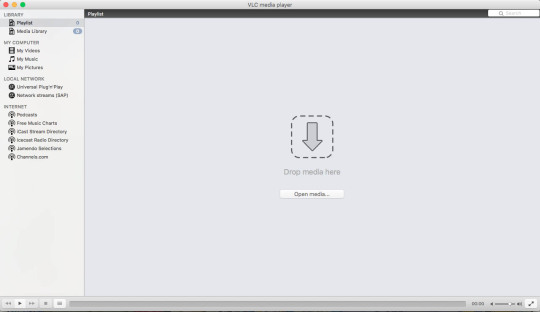
You want to go to preferences located towards the top left hang corner after clicking VLC (in bold). Something like this should then pop up:
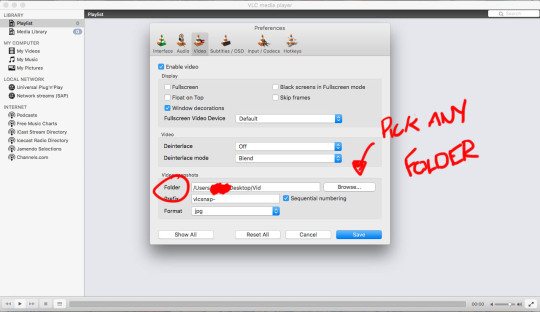
Click onto the ‘Video’ tab and select where you want your frames to be saved. Next move onto the ‘Hotkeys’ tab and find ‘Take video snapshot’ and ‘Next Frame’, setting them to which ever keys you like. Mine are set to E and ` (for no particular reason)
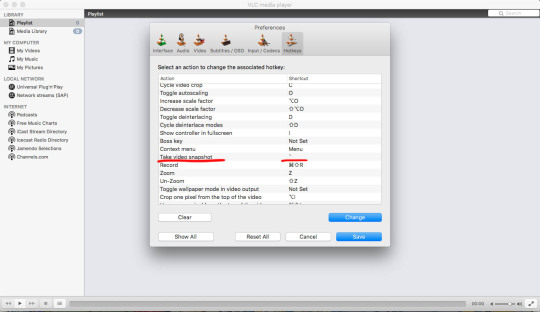
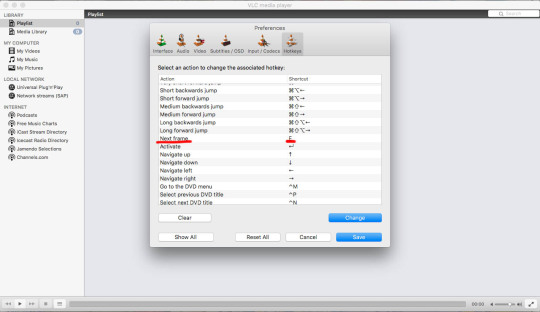
When making a gif, you’ll obviously need to have a file of whatever you wish to gif (since I’m an OP blog I’ll stick to using OP as an example). The website to torrent these from is nyaa.si. This is what it looks like:

(Me being the horrible OP nerd that I am have all episodes and movies downloaded....)
Once you have the desired episode you want, open it up in VLC.

Once you reach the part you want to gif, click your ‘Take video snapshot’ hotkey. This is what should appear once you do so:
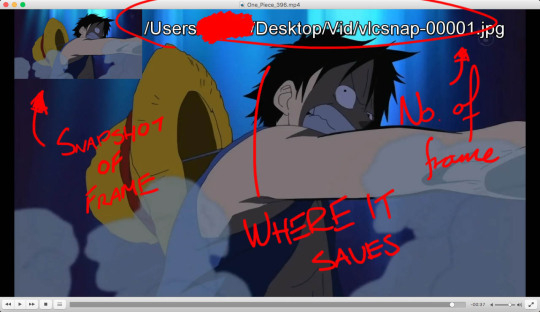
Next, you’ll have to click your ‘Next Frame’ hotkey and go through all the frames, snapshotting the ones you desire. I know it’s a really long and tedious process, especially if you’re doing large gif sets but it helps in the long run. Chuck on some tunes as to not get bored!
All of your frames will save in the desired folder, with the frames being individual images.

Now to put them together! Open up Photoshop and go to File>Scripts>Load Files into Stack.
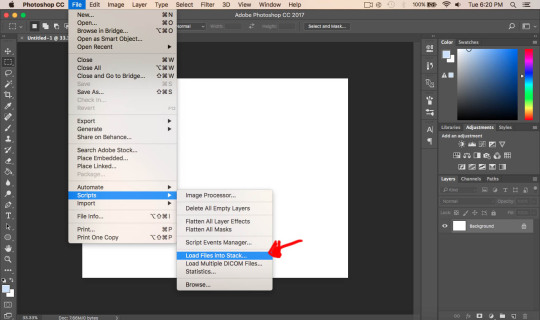
Don’t go to Import>Load files into frames (or something like that) as this makes the whole process a lot more difficult. When going through this way, you are only limited to 500 frames which can limit what you’re working on (especially if it’s a large gifset with more than 500 frames). When importing through Scripts, it will allow you more than 500 (I haven’t hit a limit yet so I’m not sure if there is one or not but so far I haven’t experienced one).
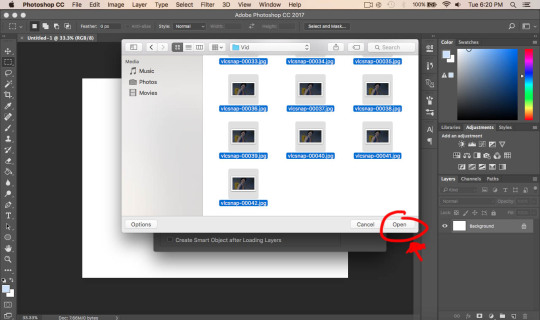
Click ‘Browse’ and find the folder with your frames, selecting all of the ones you wish to convert into a gif and click ‘Open’ and then ‘Ok’. It should look something like this:

Next, we want to display the ‘Timeline’. To do this, we have to go to Window>Timeline
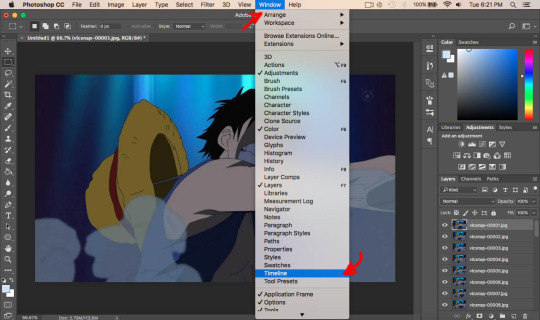
A grey box should appear on the bottom of your page. Click the little arrow where it says ‘Create Video Timeline’ and click ‘Create Frame Animation’


When done, click on the little box to the right hand side of the timeline window and click ‘Make Frames From Layers’.
Because of the size of the file, it’s too big and is lagging down Photoshop a bit, plus we need to adjust the sizing for Tumblr. To do this, go to Image>Image Size

Make sure that the width is at 540 pixels (not cm, inches, etc.) if you want a standard size. (I don’t remember the exact dimensions for Tumblr but if you want to know, do a quick google search). Also be sure to click the link to ensure it is fitted proportionately and click ‘OK’ once done.


Once again, click the little dropbox on the top right hand side of the timeline window and click ‘Reverse Frames’ (only if your frames have loaded backwards which mine always do although this may be different to you, to check just play through the frames)
Play around with timing to how you wish. I usually have mine at ‘0.08′ seconds. You can change the time down next to the small arrow where it has ‘0.00′ (Make sure all frames are selected if you want all frames to have the same time delay) Remember that when played at 0.00, it may appear normal but once saved it is a lot faster so be sure to change it
Now we want to select all frames in both the timeline and in the layers, this is important for the next step. Once selected, click the small icon at the bottom of the the left hand corner (next to ‘Once’)


Once this is converted to a video timeline, go to Filter>Convert for Smart Filters. This essentially merges all your frames/layers together and still plays as a video in the timeline. It also allows us to edit the batch of frames together instead of going through each individual frame to edit it.
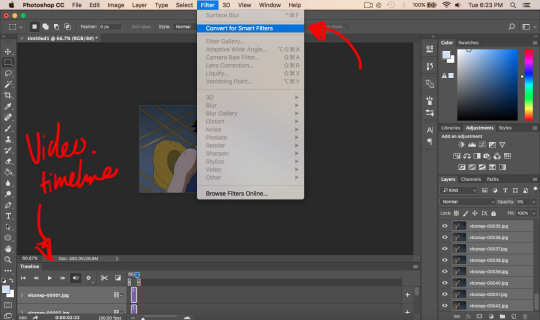
This bit of editing really helps blend colours together which helps in saving them later on. It does get rid of details here in there depending how you apply it. Go to Filter>Blue>Surface Blur and experiment around with the settings.
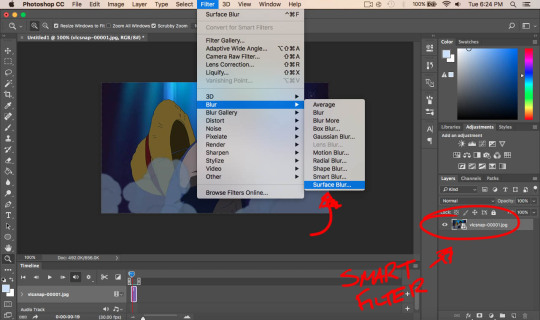
I usually keep mine at Radius: 5 and Threshold: 10. I recommend not going too far from these numbers.

Because the surface blur has blured the colours together slightly, the defining lines of the character are slightly lost. To fix this we go to Filter>Sharpen>Smart Sharpen.
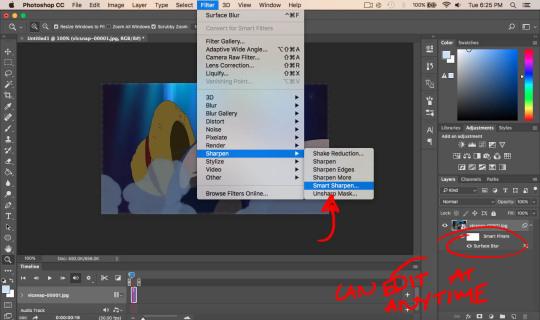
I tend to keep my radius quite low and the amount relatively low as well, it depends on the gif I’m making.

I tend to see this a lot when people make gifs and that is that they oversharpen their frames which can be quite jarring to the eye and it also doesn’t look very nice. An example of oversharpening is when white pixels surround the black like this:

Less oversharped but still so:

It makes the lines all jagged and unsmooth which is what we want to avoid.

That’s a lot better (and it could be better but notice the distinct lack of white pixels)
Now you can play around with different filters and such! I definitely recommend using some sort of filters, the anime colours are very dull and unsaturated. Once you’re happy, save your gif by going to File>Export>Save for Web
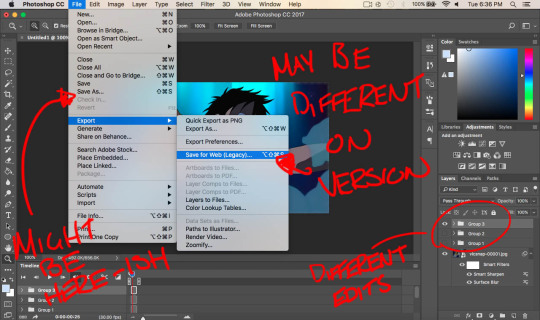
This is what the next window will look like. You can experiment with either Diffusion and Pattern. This is how the pixels on your gif will appear. I usually alternate between the two, depending on what works best with the particular gif I’m making. In this case, I’ll use Diffusion.

When saving, make sure that the size of the gif is no higher than 3mb, that is tumblr’s restriction on the size of gifs (as of making this tutorial). Also make sure that Looping Options is selected as ‘Forever’. Click ‘Save’ when you’re done! And there you go, you have your gif!
Filter 1:

Filter 2:

Filter 3:

Anime:

Notice the different palettes you can create? If you only wanted to make a gif, you’re done! However, if you want to know some more tricks, keep on reading! (I say as if this tutorial isn’t long enough)
This part is if you want your gifs to look more clean and crisp.
If you notice in my example gifs, they all have these square like patterns on there. That’s because Photoshop can only allow 256 colours, so to make up for those lack in colours, it adds pattern/diffusion to essentially replace them (or something like that lol) To fix this, go back to your gif (before saving) and select the lasso tool and select the colours that are most important in the frame.

Once done, click Image>Mode>Indexed Colour (make sure you have the history window ready)
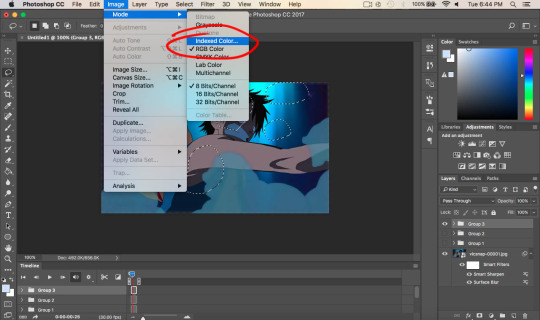
Make sure your settings are set like this (they may be by default but I don’t remember) and click ‘OK’

Now go back and save it as if you were saving it as a gif by File>Export>Save for web. This time, click the drop box and click ‘Save Colour Table’ and call it table. It will ask if you want to replace it, click ‘OK’. Once saved, click cancel and return to your gif.
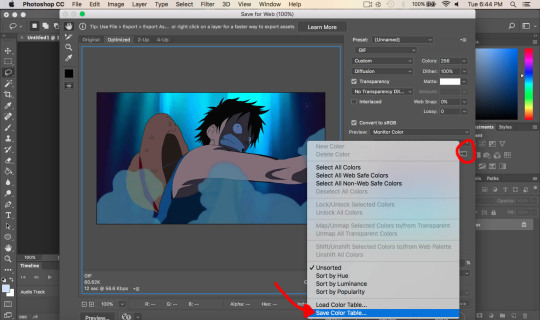
Click on the history window (if it’s not there, look under ‘Window’) and undo the ‘Indexed Colour’. When we did this, the layers all merged together and the frames have gone, meaning no more motion/movement. Make sure to undo this step!

Click the same little icon when we were saving the colour table and click load table, and select ‘table’. Similar colours will come up however now they are the most important ones. Play through the gif to ensure the colours look nice and look smooth. if not, delete some colours on the colour table by selecting the colour you wish to delete and the little trash can in the bottom right hand corner. To add colours, go to the ‘original’ tab and select the colour picker, clicking the little page icon left of the trash can. This will add the colour to the table.

This can be incredibly tedious but it changes the colours on the gif and makes it look as if it is straight from the anime. Gifs like this one needs a lot of time since the colours in the back change quite a lot.
Before:

After:

It may not look like much to those who don’t make gifs (or any difference at all) but things like these can help increase the quality of the gif. It seems like a really long and tedious process (to which it is trust me) but I think it’s worth it in the end!
For comparisons sake, here’s diffusion (first) compared to pattern (second)


If anyone has any questions regarding this tutorial, feel free to message me and I can try help you out!
If you read this far, thank you so much! I spent a lot of time on this tutorial so I’m grateful if you took time out of your day to read this. Have a good day!!
#gif#tutorial#anime#opgraphics#one piece#monkey d. luffy#GOD#this took 3 hours to make#more than that#I'm lowkey embarrassed#oh well#I hope it wasn't too confusing#but yeah making gifs is tiring#blegh#mine
62 notes
·
View notes
Text
Oculus Quest 2 Review: The Best Headset for Everyone
Oculus Quest 2
9.00 / 10
Read Reviews
Read More Reviews
Read More Reviews
Read More Reviews
Read More Reviews
Read More Reviews
Read More Reviews
Read More Reviews
Read More Reviews
Read More Reviews
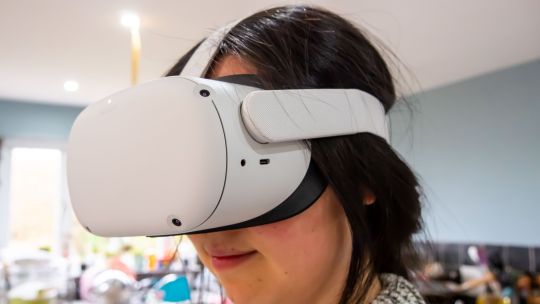
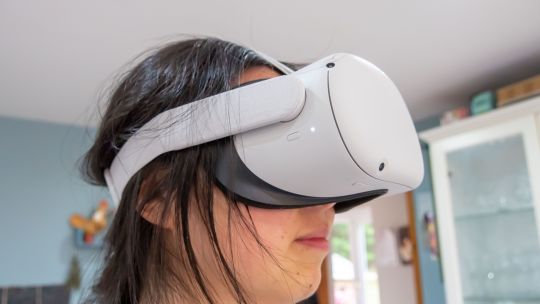
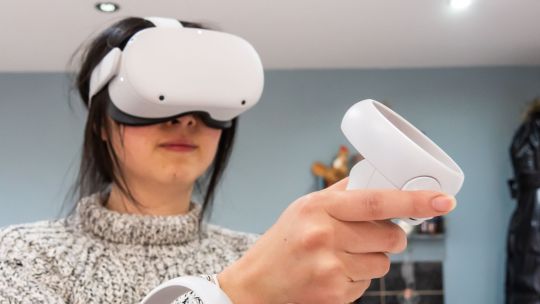

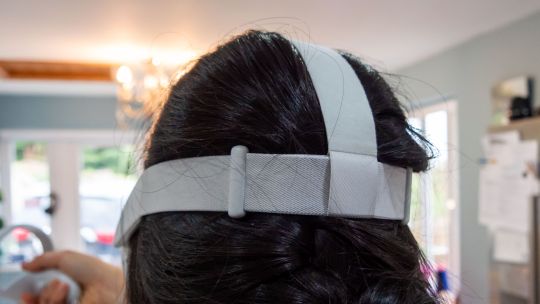
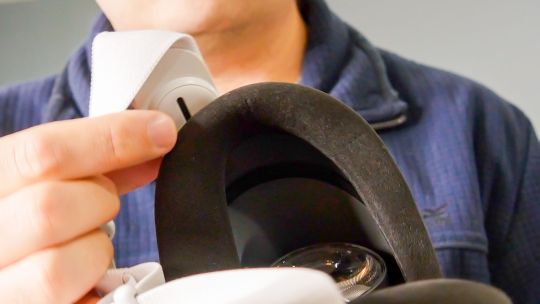



See on amazon
Not only is the Oculus Quest 2 the best standalone VR headset yet, it's also the best budget option for PC gaming thanks to the Oculus Link technology. At the incredible price point of $300, it's an essential purchase for anyone looking to get into VR. Existing Oculus Quest owners might be disappointed by the black levels, but we think the increased resolution and responsiveness is well worth the trade-off.
Specifications
Brand: Oculus (Facebook)
Resolution (per eye): 1832 x 1920px
Display Type: RGB-stripe LCD
Storage: 64 / 256 GB
Connectivity: Wi-Fi 6 and 802.11ac, Bluetooth 5.0, USB-C, 3.5mm Stereo Out
Battery Life: 2-3 Hours
Tracking Technology: Inside out cameras on the headset
Audio: Built-in speakers
Weight: 1.1 lbs
Pros
Hand-tracking is reliable, though not all software supports it yet
RGB-stripe LCD adds resolution and pixel density, eliminating any screen-door effect
Incredible value for a standalone headset, and a great buget choice for PC gaming
Cons
Audio is terrible, but easy enough to plug in your own headphones
Black levels are worse than the original Quest
Buy This Product

Oculus Quest 2 amazon
Shop
<![CDATA[ // Bottom var galleryThumbs1 = new Swiper('.gallery-thumbs-1', { spaceBetween: 10, slidesPerView: 10, freeMode: true, watchSlidesVisibility: true, watchSlidesProgress: true, centerInsufficientSlides: true, allowTouchMove: false, preventClicks: false, breakpoints: { 1024: { slidesPerView: 6, } }, }); // Top var galleryTop1 = new Swiper('.gallery-top-1', { spaceBetween: 10, allowTouchMove: false, loop: true, preventClicks: false, breakpoints: { 1024: { allowTouchMove: true, } }, navigation: { nextEl: '.swiper-button-next', prevEl: '.swiper-button-prev', }, thumbs: { swiper: galleryThumbs1 } }); ]]>
An incredible resolution, powerful mobile processor, and extensive software library make the Oculus Quest 2 the best wireless VR headset yet. And if you have the right cable and a gaming PC, it's also the best budget PC VR headset. That's quite an achievement–especially at a price point of just $300.
Read on to find out why the Oculus Quest 2 is the best mobile VR experience yet.
youtube
Why Should You Trust My Opinion?
I've been following 3D display technologies since the early 2000s, starting with NVidia's 3DVision. I backed the original Oculus Development Kit Kickstarter after reading about it from an MTBS3D forum member. From the moment it arrived, I knew it would change gaming forever, despite only a single demo being available.

I kept throwing money at VR, on the Dev Kit 2, consumer edition Rift, HTC Vive (eventually with wireless upgrade), Oculus Go, and Oculus Quest. My current headset of choice is the Valve Index, though I probably use the Quest more than anything because of its convenience.
Note the absence of the Rift S. I knew at the time it was a dead-end for Oculus, bridging the gap while they perfected Oculus Link technology. I was right, and Facebook has confirmed that the Rift hardware ends here, with all future efforts pushed to the mobile space.
We’re going to focus on standalone VR headsets moving forward. We’ll no longer pursue PC-only hardware, with sales of Rift S ending in 2021. That said, the Rift Platform isn’t going anywhere. In fact, we've seen significant growth in PC VR via Oculus Link, and the Rift Platform will continue to grow while offering high-end PC VR experiences like Lone Echo II and Medal of Honor: Above and Beyond well into the future. - Oculus.com
Quest 2 Technical Specs and Design
Aesthetically, the Quest 2 has undergone one significant change: it's now white. This is undoubtedly the result of numerous psychological studies that told Facebook that white was a more acceptable color for consumer electronics destined for use in the living room. And they're probably right, given that sales of the Oculus Quest 2 are so far outstripping the original many times over. Other than that, the shape and overall design of the Quest 2 is relatively unchanged.

It ships with a flimsy head strap that tends to fall off in vigorous use and results in a weight distribution that's uncomfortably forward-heavy on the face. While Oculus sells a replacement "Elite" strap with a ratcheting lock, it's overpriced, and early reports indicate it's poorly made and prone to snapping. You'll find a better one on AliExpress.

There are two versions of the Quest 2 available to purchase, differing only in the amount of storage space. The basic model at $300 has 64GB, while $400 will get you significantly more at 256GB. If you plan only to play games, 64GB is plenty enough. If you want to store big movies to watch offline when traveling, 256GB will likely be your best bet.
You can expect anywhere from two to three hours of use from the battery on the Oculus Quest 2. Two hours if you're playing games, three if you're watching movies. To ensure there's any battery left when you next pick it up, remember to power off the device completely by holding the power button and selecting "shutdown." Merely taking the headset off will turn the screen off, but the system will be paused and run the battery down in a day or so. The Elite Strap includes a battery which will give another two to three hours. There is no battery limitation when tethered to a PC.

A USB-C charging cable and adaptor are also included in the package, though it's not long enough to be used for Oculus Link. A glasses adaptor is provided for those who find the headset is bumping up against their own lenses, which extends the face plate about 1/4 inch further out. It's easy to fit as the faceplate is simple to remove.
Visual Quality
The screen inside the Oculus Quest is perhaps the most significant change compared to the Quest, and it's not all for the better. Running at a higher overall resolution of 1832x1920 pixels per eye, compared to 1440x1600 on the Quest, Facebook opted for a single RGB-stripe LCD panel. The RGB-stripe configuration results in pixels that are closer together, and therefore higher density. This eliminates any so-called "screen door effect" and generally gives a higher perceived resolution (on top of a higher actual and ix resolution). Combined, it results in an incredibly sharp display. The display is also now capable of running at 90Hz, though this is not enabled by default, and most games don't take advantage of it yet. If I sound like I'm glossing over this point, it's because the 75Hz refresh has never bothered me.
Unfortunately, the choice of a single panel LCD, rather than dual-panel OLEDs found in the original Quest, has two significant drawbacks.

The first is the lack of real IPD (inter-pupillary distance) adjustment. Facebook has compromised and provided three discrete physical IPD settings, which you can click into place. These should cover everyone from 58mm to 68mm, though only those with the entirely average 63mm will get the best experience, and there's no software adjustment to accompany this—it's physically moving the position of the lenses. Therefore the area of the image you're focusing on also slightly changes. Sadly I can't comment on how non-ideal it is for other IPDs, as I fall into the category of entirely average.
The other drawback of using an LCD panel is the black levels. In short, they're more dark grey than black. If you play horror games, such as Walking Dead: Saints and Sinners, or enjoy watching darker movies in your personal VR cinema, you may notice it more than others.
To be clear, these are minor complaints. Other improvements in the resolution and pixel density far outweigh any perceived issue with black levels.
Audio Quality
The audio system feels upgraded but still terrible. Sound emanates from somewhere within the headset and is piped to your ears via the plastic clips on the side. Unfortunately, I'd forgotten how bad it sounds, having replaced the head strap on my original Quest with some 3D printed adaptors and the HTC Vive Deluxe Audio Strap.

Though the sound quality is clean and gets pretty loud, with no muffled voices or distortion, it completely lacks bass. On top of that, there is no audio isolation at all. Partly, this is by design: Facebook wants you to stay somewhat connected to the outside world. But it works both ways, and the outside world can hear everything you do in VR.
Of course, you can fix the audio easily, so it's not a dealbreaker. A single 3.5mm stereo jack on the left-hand side enables you to plug in earbuds or your favorite cans. But that's some ugly wires on what is other an elegantly minimalist design.
Controllers
The controllers are also superficially unchanged other than being white now, with the same selection of capacitive buttons, a thumbstick, trigger, and grip button. This configuration means existing library software should work as is, with little required for developers to update code. A single AA battery powers each controller, with a ring of invisible tracking LEDs.

Upon closer examination, they appear to be slightly larger than the original controllers, though not noticeably so in use. I still find my hands cramping up after extended sessions. A capacitive thumb rest has been added.
Tracking, Passthrough, and Hands
Though the tracking technology also appears to be unchanged–with four cameras on the headset watching the LEDs embedded in the controller–it certainly feels smoother. The additional processing in the CPU results in less overall tracking hiccups, such that any blame for missed blocks in BeatSaber is now squarely on your shoulders.
Hand-tracking too feels distinctly smoother and more reliable. It feels like a viable way to interact with the system now, though not all software has been updated to use it.

Also greatly improved is the camera passthrough feature. A quick double-tap on the side of the headset immediately reveals your surroundings, so you can step over the cat, take a sip of coffee, or inflict a brutal tickling on your child who thinks daddy can't see anything when he's wearing his headset.
Got a PC? Plug It In with Oculus Quest Link
While the Oculus Quest 2 delivers an incredible wireless VR experience, the graphical quality will never compare to those rendered on a desktop gaming PC. But with Quest 2, you needn't choose. Just plug in the Quest 2 using a USB-C to USB-C or USB-A cable, and you can enjoy full access to the desktop Oculus software or vast Steam library. Graphics will be rendered on your PC and sent to the Oculus Quest 2, just like any other tethered PC headset. I expect you're asking yourself, "can I play Half-Life Alyx on the Oculus Quest 2?!" and the answer is a resounding yes. Valve hasn't locked its games to any particular headset, and with full SteamVR access and native controller support, everything works as expected. And it's incredible.

Oculus sells a branded fiber-optic Link cable for the best quality, though it's quite pricey at around $90. This Belkin cable is also officially compatible. If you have a USB2.0 cable (strangely, not all USB-C cables are rated for USB3.0 transfer speeds), you can still use Oculus Link, though the visual clarity will be somewhat degraded.
You probably think this is a bad experience compared to a "normal" wired headset. While it doesn't quite compare to the $1000 Index, it's certainly not what I'd call subpar. I've used a lot of tethered VR headsets and would be quite happy using just the Quest 2.
As for Quest Link latency: it's imperceivable. Even in fast-paced FPS games, or rhythm action titles like Beat Saber, I couldn't notice any latency. For comparison sake, I usually use a Valve Index tethered to my gaming PC.
Games on Oculus Quest
I tested in three games: Rec Room, Beat Saber, and Walking Dead: Saints and Sinners. The former two I have many hours of playing across platforms, so I'm intimately familiar with them. The latter I bought to compare directly the Quest 1 and 2, with fresh pair of eyes.
Overall, it was a mixed bag of results.
Beat Saber appears to be updated, and as far as I can tell, it takes full advantage of the resolution bump. The strobing lights and bright contrasts work particularly well on this type of display.
Rec Room, however, felt like legacy software. Though it's opened some additional maps for Quest 2 users to take advantage of additional graphical capabilities, the game appears to run at a lower resolution than the Quest 2 is capable of. The screen felt darker, with colors more muted than the Quest 1. I then compared to the SteamVR version of RecRoom over Oculus Link, and sure enough, it was a world of difference with bright visuals, even over a USB2 cable.

Walking Dead: Saints and Sinners is about as gloomy as a game can get, played mostly under cover of darkness, with fog effects galore. And sure enough, the black levels here were a murky dark grey at best. Swapping back and forth between Quest 1 and 2 highlights the screen differences. That said, given a choice between higher resolution or better black levels, I'd choose the higher resolution every time.

Of course, it should go without saying that these are my subjective opinions only, and your experience may vary.
The F-Word: Facebook
We can't review the Oculus Quest 2 and not mention the requisite Facebook account. While the Quest 2 has excellent hand-tracking, that's probably not the only thing it's tracking. As is written clearly on the box, this device requires a Facebook account. No ifs, no buts, no workarounds, no opt-out. And not just for social integrations (as was previously the case), but to merely activate and use your device.
If you're thinking, "that's ok, I'll just make a fake account," then think again: many users have found their fake accounts deleted and have lost access to all their Oculus purchases. Not only do you need a Facebook account to use the Quest 2, but you also need a real, active account. You'll be asked to submit a photo ID if Facebook suspects shenanigans.
Precisely what privacy implications this will hold in the future is yet to be determined. Will Facebook be able to watch everything you do in VR? It seems unlikely, though it is technically possible. For now, Facebook has stated that it'll be strongly moderating user actions within the new Horizons social VR space, currently in beta for selected users. A rolling camera (similar to a car dashcam) will record everything you do, and if another user reports you, the relevant footage will be saved and uploaded for manual review. Facebook employees will also be able to drop in on your at any point and remain invisible to observe your behavior. While this sounds terrifying to some, it may be precisely what social VR spaces need to succeed. The potential for long-term psychological harm in online social networks is somewhat limited when interactions are text-only. In VR's physical space, they're on a whole other level.

Personally, I couldn't care less. I merged my Facebook and Oculus account a long time ago. If I did have a dark alter-ego where I live out sadistic fantasies or troll feminist gamers, I probably wouldn't be doing it anywhere near the account where my mum is.
But for those of you who are entirely Facebook averse, I doubt the technological progress that the Quest 2 brings will be enough to convince you otherwise. In which case, consider yourself out of the mobile VR game because there isn't a worthwhile alternative.
Should You Upgrade From the Quest?
The original Oculus Quest felt like a mid-range smartphone unwillingly coerced into doing double duty as a VR headset. It was still the best VR experience at the time of release, and throughout its lifecycle, no other viable contender stepped up.
The Quest 2, however, flies along, doing whatever it's told with glee. While the Quest's hardware inadequacies remain unchanged (the horrendous audio and uncomfortable headset), it's understandable that some compromises had to be made to get a high-resolution wireless all-in-one VR headset down to the frankly ludicrous price point of $300. Facebook has delivered on its promise of making VR accessible for the masses, and we should praise it for that endeavor. If we need to give up a little privacy for that, then so be it. VR's ability to teleport us to anywhere we can dream of is a powerful tool for change, and I want everyone to have that opportunity.
As for whether you should upgrade? It's debatable. Personally, the resolution bump, more powerful processor, and generally more responsive UI throughout are more than worth it. I would have happily paid $500 for a "Pro" version of the Quest 2, with an OLED screen and possibly better audio, but I'm pleased with the upgrade. I'll add some padding to the controllers and replace the head strap; such is the convenience of a world with 3D printing. I'm not a massive fan of horror movies or scary games—there's enough horror in real life. I want my VR experiences to be bright and colorful. But if you know you're a stickler for black levels, you might want to hold off.
The Oculus Quest 2 isn't just the best mobile headset, with a gimmicky feature that lets you plug it into a PC. It's the best budget PC VR headset, too. While it may be a questionable upgrade for some original Quest owners, it's the best choice if you don't already have a VR headset. You will not be disappointed.
Do You Have Oculus Quest 2 Questions? We've Got Answers!
How much do Oculus Quest games cost?
Games in the Oculus Quest library cost anywhere from nothing (Rec Room, with in-app purchases for cosmetic items that you can also buy with earned currency) to $19 per month for Supernatural VR, a fitness game with licensed music. Most fall between the $5–$20 mark.
How Big Are Oculus Quest 2 Games?
If you're considering whether to buy the 64GB or 256GB Oculus Quest 2, you should know that even the biggest Quest game is around 8GB, meaning you can comfortably fit several on the 64GB model. Most games (and apps) are under 1GB. If you just plan to play games and not store large movies, 64GB is plenty enough.
How to Stream Oculus Quest to Twitch?
By default, you can stream to the Oculus app on your phone, a Chromecast 3 device, or your personal Facebook page. For anything else, like Twitch, you'll need some cables and a PC. Using a USB-C cable, the ScrCpy utility (built into SideQuest) will display the visuals, while you'll also need a stereo audio cable to capture sound. You can then pipe this through the usual desktop app like OBS and out to your platform of choice.
Can I Play Custom BeatSaber Songs on Quest 2?
Yes, but it's not a simple process. You'll need to first enable Developer Mode and install SideQuest, a third-party unofficial app store and method of adding generic APKs to your Quest. Then you'll need to install BMBF, which includes the BeatSync mod. This will give you access to custom songs from BSaber.
How Does Oculus Quest 2 Tracking Work?
The Quest 2 features four small cameras embedded in the headset. These watch your play space to figure out how your head is moving. At the same time, there is a ring of infra-red LEDs on each controller, which only the headset can see. Combined, you have full freedom of movement and motion controls in a standalone package. A virtual Guardian wall will prevent you from leaving the play area. You can either draw this using the passthrough cameras, or opt for a standing-only play area (in which you can turn around, but stay in one spot). The wide-angle cameras situated on the sides and bottom of the Quest 2 ensure ample coverage. While moving your controller around your back will force it to lose tracking, this rarely occurs in practice. The Oculus Quest 2 tracking cannot fully function in darkness: it must see your environment. If it's unable to track your surroundings, the system will revert to a 3DOF mode, whereby you can only rotate the headset and have no positional tracking. This mode is fine for watching movies in a dark environment.
Does Oculus Quest 2 Have Full Body Tracking?
No. While the Quest 2 is capable of tracking your hands (without using controllers), it's not able to track your feet or the rest of your body. Full-body tracking is only possible using third-party hardware in tethered Oculus Link mode.
Oculus Quest 2 Review: The Best Headset for Everyone posted first on grassroutespage.blogspot.com
0 notes
Text
Oculus Quest 2 Review: The Best Headset for Everyone
Oculus Quest 2
9.00 / 10
Read Reviews
Read More Reviews
Read More Reviews
Read More Reviews
Read More Reviews
Read More Reviews
Read More Reviews
Read More Reviews
Read More Reviews
Read More Reviews
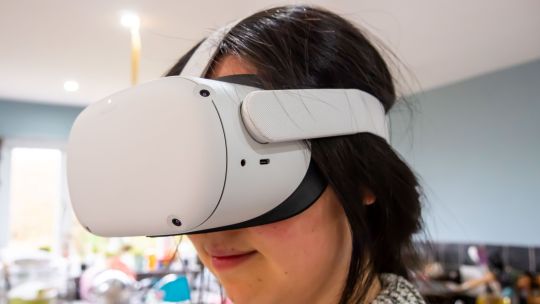
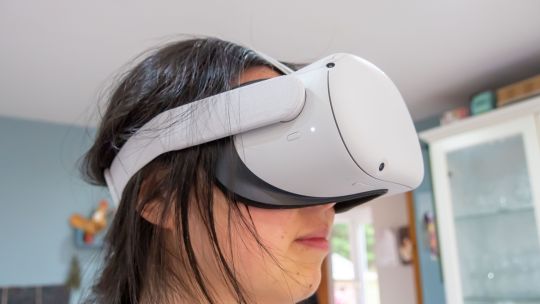
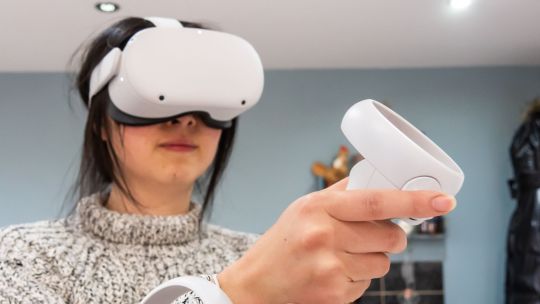
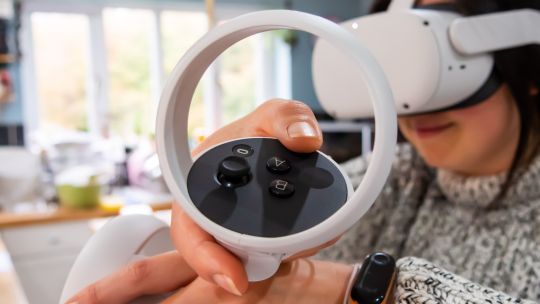
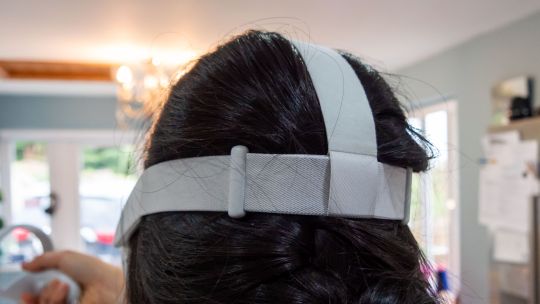
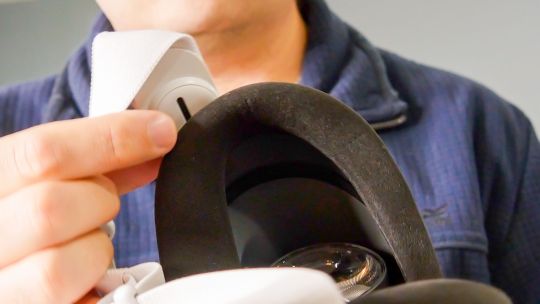
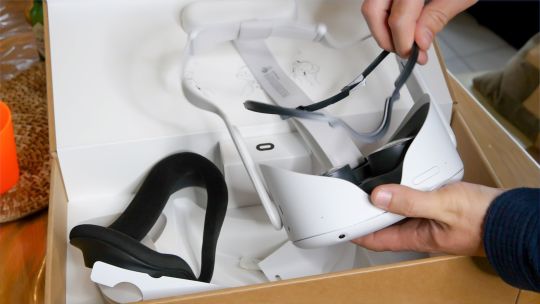


See on amazon
Not only is the Oculus Quest 2 the best standalone VR headset yet, it's also the best budget option for PC gaming thanks to the Oculus Link technology. At the incredible price point of $300, it's an essential purchase for anyone looking to get into VR. Existing Oculus Quest owners might be disappointed by the black levels, but we think the increased resolution and responsiveness is well worth the trade-off.
Specifications
Brand: Oculus (Facebook)
Resolution (per eye): 1832 x 1920px
Display Type: RGB-stripe LCD
Storage: 64 / 256 GB
Connectivity: Wi-Fi 6 and 802.11ac, Bluetooth 5.0, USB-C, 3.5mm Stereo Out
Battery Life: 2-3 Hours
Tracking Technology: Inside out cameras on the headset
Audio: Built-in speakers
Weight: 1.1 lbs
Pros
Hand-tracking is reliable, though not all software supports it yet
RGB-stripe LCD adds resolution and pixel density, eliminating any screen-door effect
Incredible value for a standalone headset, and a great buget choice for PC gaming
Cons
Audio is terrible, but easy enough to plug in your own headphones
Black levels are worse than the original Quest
Buy This Product

Oculus Quest 2 amazon
Shop
// Bottom var galleryThumbs1 = new Swiper('.gallery-thumbs-1', { spaceBetween: 10, slidesPerView: 10, freeMode: true, watchSlidesVisibility: true, watchSlidesProgress: true, centerInsufficientSlides: true, allowTouchMove: false, preventClicks: false, breakpoints: { 1024: { slidesPerView: 6, } }, }); // Top var galleryTop1 = new Swiper('.gallery-top-1', { spaceBetween: 10, allowTouchMove: false, loop: true, preventClicks: false, breakpoints: { 1024: { allowTouchMove: true, } }, navigation: { nextEl: '.swiper-button-next', prevEl: '.swiper-button-prev', }, thumbs: { swiper: galleryThumbs1 } });
An incredible resolution, powerful mobile processor, and extensive software library make the Oculus Quest 2 the best wireless VR headset yet. And if you have the right cable and a gaming PC, it's also the best budget PC VR headset. That's quite an achievement–especially at a price point of just $300.
Read on to find out why the Oculus Quest 2 is the best mobile VR experience yet.
youtube
Why Should You Trust My Opinion?
I've been following 3D display technologies since the early 2000s, starting with NVidia's 3DVision. I backed the original Oculus Development Kit Kickstarter after reading about it from an MTBS3D forum member. From the moment it arrived, I knew it would change gaming forever, despite only a single demo being available.
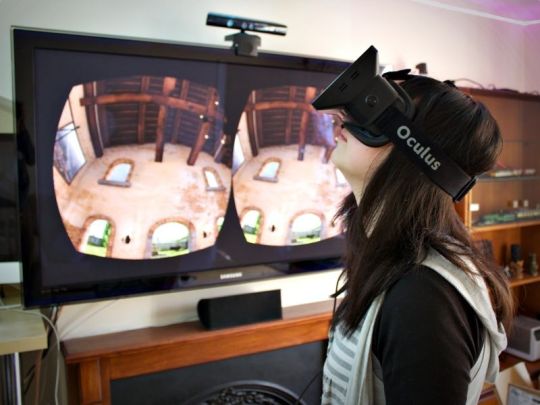
I kept throwing money at VR, on the Dev Kit 2, consumer edition Rift, HTC Vive (eventually with wireless upgrade), Oculus Go, and Oculus Quest. My current headset of choice is the Valve Index, though I probably use the Quest more than anything because of its convenience.
Note the absence of the Rift S. I knew at the time it was a dead-end for Oculus, bridging the gap while they perfected Oculus Link technology. I was right, and Facebook has confirmed that the Rift hardware ends here, with all future efforts pushed to the mobile space.
We’re going to focus on standalone VR headsets moving forward. We’ll no longer pursue PC-only hardware, with sales of Rift S ending in 2021. That said, the Rift Platform isn’t going anywhere. In fact, we've seen significant growth in PC VR via Oculus Link, and the Rift Platform will continue to grow while offering high-end PC VR experiences like Lone Echo II and Medal of Honor: Above and Beyond well into the future. - Oculus.com
Quest 2 Technical Specs and Design
Aesthetically, the Quest 2 has undergone one significant change: it's now white. This is undoubtedly the result of numerous psychological studies that told Facebook that white was a more acceptable color for consumer electronics destined for use in the living room. And they're probably right, given that sales of the Oculus Quest 2 are so far outstripping the original many times over. Other than that, the shape and overall design of the Quest 2 is relatively unchanged.

It ships with a flimsy head strap that tends to fall off in vigorous use and results in a weight distribution that's uncomfortably forward-heavy on the face. While Oculus sells a replacement "Elite" strap with a ratcheting lock, it's overpriced, and early reports indicate it's poorly made and prone to snapping. You'll find a better one on AliExpress.

There are two versions of the Quest 2 available to purchase, differing only in the amount of storage space. The basic model at $300 has 64GB, while $400 will get you significantly more at 256GB. If you plan only to play games, 64GB is plenty enough. If you want to store big movies to watch offline when traveling, 256GB will likely be your best bet.
You can expect anywhere from two to three hours of use from the battery on the Oculus Quest 2. Two hours if you're playing games, three if you're watching movies. To ensure there's any battery left when you next pick it up, remember to power off the device completely by holding the power button and selecting "shutdown." Merely taking the headset off will turn the screen off, but the system will be paused and run the battery down in a day or so. The Elite Strap includes a battery which will give another two to three hours. There is no battery limitation when tethered to a PC.

A USB-C charging cable and adaptor are also included in the package, though it's not long enough to be used for Oculus Link. A glasses adaptor is provided for those who find the headset is bumping up against their own lenses, which extends the face plate about 1/4 inch further out. It's easy to fit as the faceplate is simple to remove.
Visual Quality
The screen inside the Oculus Quest is perhaps the most significant change compared to the Quest, and it's not all for the better. Running at a higher overall resolution of 1832x1920 pixels per eye, compared to 1440x1600 on the Quest, Facebook opted for a single RGB-stripe LCD panel. The RGB-stripe configuration results in pixels that are closer together, and therefore higher density. This eliminates any so-called "screen door effect" and generally gives a higher perceived resolution (on top of a higher actual and ix resolution). Combined, it results in an incredibly sharp display. The display is also now capable of running at 90Hz, though this is not enabled by default, and most games don't take advantage of it yet. If I sound like I'm glossing over this point, it's because the 75Hz refresh has never bothered me.
Unfortunately, the choice of a single panel LCD, rather than dual-panel OLEDs found in the original Quest, has two significant drawbacks.

The first is the lack of real IPD (inter-pupillary distance) adjustment. Facebook has compromised and provided three discrete physical IPD settings, which you can click into place. These should cover everyone from 58mm to 68mm, though only those with the entirely average 63mm will get the best experience, and there's no software adjustment to accompany this—it's physically moving the position of the lenses. Therefore the area of the image you're focusing on also slightly changes. Sadly I can't comment on how non-ideal it is for other IPDs, as I fall into the category of entirely average.
The other drawback of using an LCD panel is the black levels. In short, they're more dark grey than black. If you play horror games, such as Walking Dead: Saints and Sinners, or enjoy watching darker movies in your personal VR cinema, you may notice it more than others.
To be clear, these are minor complaints. Other improvements in the resolution and pixel density far outweigh any perceived issue with black levels.
Audio Quality
The audio system feels upgraded but still terrible. Sound emanates from somewhere within the headset and is piped to your ears via the plastic clips on the side. Unfortunately, I'd forgotten how bad it sounds, having replaced the head strap on my original Quest with some 3D printed adaptors and the HTC Vive Deluxe Audio Strap.

Though the sound quality is clean and gets pretty loud, with no muffled voices or distortion, it completely lacks bass. On top of that, there is no audio isolation at all. Partly, this is by design: Facebook wants you to stay somewhat connected to the outside world. But it works both ways, and the outside world can hear everything you do in VR.
Of course, you can fix the audio easily, so it's not a dealbreaker. A single 3.5mm stereo jack on the left-hand side enables you to plug in earbuds or your favorite cans. But that's some ugly wires on what is other an elegantly minimalist design.
Controllers
The controllers are also superficially unchanged other than being white now, with the same selection of capacitive buttons, a thumbstick, trigger, and grip button. This configuration means existing library software should work as is, with little required for developers to update code. A single AA battery powers each controller, with a ring of invisible tracking LEDs.

Upon closer examination, they appear to be slightly larger than the original controllers, though not noticeably so in use. I still find my hands cramping up after extended sessions. A capacitive thumb rest has been added.
Tracking, Passthrough, and Hands
Though the tracking technology also appears to be unchanged–with four cameras on the headset watching the LEDs embedded in the controller–it certainly feels smoother. The additional processing in the CPU results in less overall tracking hiccups, such that any blame for missed blocks in BeatSaber is now squarely on your shoulders.
Hand-tracking too feels distinctly smoother and more reliable. It feels like a viable way to interact with the system now, though not all software has been updated to use it.

Also greatly improved is the camera passthrough feature. A quick double-tap on the side of the headset immediately reveals your surroundings, so you can step over the cat, take a sip of coffee, or inflict a brutal tickling on your child who thinks daddy can't see anything when he's wearing his headset.
Got a PC? Plug It In with Oculus Quest Link
While the Oculus Quest 2 delivers an incredible wireless VR experience, the graphical quality will never compare to those rendered on a desktop gaming PC. But with Quest 2, you needn't choose. Just plug in the Quest 2 using a USB-C to USB-C or USB-A cable, and you can enjoy full access to the desktop Oculus software or vast Steam library. Graphics will be rendered on your PC and sent to the Oculus Quest 2, just like any other tethered PC headset. I expect you're asking yourself, "can I play Half-Life Alyx on the Oculus Quest 2?!" and the answer is a resounding yes. Valve hasn't locked its games to any particular headset, and with full SteamVR access and native controller support, everything works as expected. And it's incredible.

Oculus sells a branded fiber-optic Link cable for the best quality, though it's quite pricey at around $90. This Belkin cable is also officially compatible. If you have a USB2.0 cable (strangely, not all USB-C cables are rated for USB3.0 transfer speeds), you can still use Oculus Link, though the visual clarity will be somewhat degraded.
You probably think this is a bad experience compared to a "normal" wired headset. While it doesn't quite compare to the $1000 Index, it's certainly not what I'd call subpar. I've used a lot of tethered VR headsets and would be quite happy using just the Quest 2.
As for Quest Link latency: it's imperceivable. Even in fast-paced FPS games, or rhythm action titles like Beat Saber, I couldn't notice any latency. For comparison sake, I usually use a Valve Index tethered to my gaming PC.
Games on Oculus Quest
I tested in three games: Rec Room, Beat Saber, and Walking Dead: Saints and Sinners. The former two I have many hours of playing across platforms, so I'm intimately familiar with them. The latter I bought to compare directly the Quest 1 and 2, with fresh pair of eyes.
Overall, it was a mixed bag of results.
Beat Saber appears to be updated, and as far as I can tell, it takes full advantage of the resolution bump. The strobing lights and bright contrasts work particularly well on this type of display.
Rec Room, however, felt like legacy software. Though it's opened some additional maps for Quest 2 users to take advantage of additional graphical capabilities, the game appears to run at a lower resolution than the Quest 2 is capable of. The screen felt darker, with colors more muted than the Quest 1. I then compared to the SteamVR version of RecRoom over Oculus Link, and sure enough, it was a world of difference with bright visuals, even over a USB2 cable.

Walking Dead: Saints and Sinners is about as gloomy as a game can get, played mostly under cover of darkness, with fog effects galore. And sure enough, the black levels here were a murky dark grey at best. Swapping back and forth between Quest 1 and 2 highlights the screen differences. That said, given a choice between higher resolution or better black levels, I'd choose the higher resolution every time.

Of course, it should go without saying that these are my subjective opinions only, and your experience may vary.
The F-Word: Facebook
We can't review the Oculus Quest 2 and not mention the requisite Facebook account. While the Quest 2 has excellent hand-tracking, that's probably not the only thing it's tracking. As is written clearly on the box, this device requires a Facebook account. No ifs, no buts, no workarounds, no opt-out. And not just for social integrations (as was previously the case), but to merely activate and use your device.
If you're thinking, "that's ok, I'll just make a fake account," then think again: many users have found their fake accounts deleted and have lost access to all their Oculus purchases. Not only do you need a Facebook account to use the Quest 2, but you also need a real, active account. You'll be asked to submit a photo ID if Facebook suspects shenanigans.
Precisely what privacy implications this will hold in the future is yet to be determined. Will Facebook be able to watch everything you do in VR? It seems unlikely, though it is technically possible. For now, Facebook has stated that it'll be strongly moderating user actions within the new Horizons social VR space, currently in beta for selected users. A rolling camera (similar to a car dashcam) will record everything you do, and if another user reports you, the relevant footage will be saved and uploaded for manual review. Facebook employees will also be able to drop in on your at any point and remain invisible to observe your behavior. While this sounds terrifying to some, it may be precisely what social VR spaces need to succeed. The potential for long-term psychological harm in online social networks is somewhat limited when interactions are text-only. In VR's physical space, they're on a whole other level.

Personally, I couldn't care less. I merged my Facebook and Oculus account a long time ago. If I did have a dark alter-ego where I live out sadistic fantasies or troll feminist gamers, I probably wouldn't be doing it anywhere near the account where my mum is.
But for those of you who are entirely Facebook averse, I doubt the technological progress that the Quest 2 brings will be enough to convince you otherwise. In which case, consider yourself out of the mobile VR game because there isn't a worthwhile alternative.
Should You Upgrade From the Quest?
The original Oculus Quest felt like a mid-range smartphone unwillingly coerced into doing double duty as a VR headset. It was still the best VR experience at the time of release, and throughout its lifecycle, no other viable contender stepped up.
The Quest 2, however, flies along, doing whatever it's told with glee. While the Quest's hardware inadequacies remain unchanged (the horrendous audio and uncomfortable headset), it's understandable that some compromises had to be made to get a high-resolution wireless all-in-one VR headset down to the frankly ludicrous price point of $300. Facebook has delivered on its promise of making VR accessible for the masses, and we should praise it for that endeavor. If we need to give up a little privacy for that, then so be it. VR's ability to teleport us to anywhere we can dream of is a powerful tool for change, and I want everyone to have that opportunity.
As for whether you should upgrade? It's debatable. Personally, the resolution bump, more powerful processor, and generally more responsive UI throughout are more than worth it. I would have happily paid $500 for a "Pro" version of the Quest 2, with an OLED screen and possibly better audio, but I'm pleased with the upgrade. I'll add some padding to the controllers and replace the head strap; such is the convenience of a world with 3D printing. I'm not a massive fan of horror movies or scary games—there's enough horror in real life. I want my VR experiences to be bright and colorful. But if you know you're a stickler for black levels, you might want to hold off.
The Oculus Quest 2 isn't just the best mobile headset, with a gimmicky feature that lets you plug it into a PC. It's the best budget PC VR headset, too. While it may be a questionable upgrade for some original Quest owners, it's the best choice if you don't already have a VR headset. You will not be disappointed.
Do You Have Oculus Quest 2 Questions? We've Got Answers!
How much do Oculus Quest games cost?
Games in the Oculus Quest library cost anywhere from nothing (Rec Room, with in-app purchases for cosmetic items that you can also buy with earned currency) to $19 per month for Supernatural VR, a fitness game with licensed music. Most fall between the $5–$20 mark.
How Big Are Oculus Quest 2 Games?
If you're considering whether to buy the 64GB or 256GB Oculus Quest 2, you should know that even the biggest Quest game is around 8GB, meaning you can comfortably fit several on the 64GB model. Most games (and apps) are under 1GB. If you just plan to play games and not store large movies, 64GB is plenty enough.
How to Stream Oculus Quest to Twitch?
By default, you can stream to the Oculus app on your phone, a Chromecast 3 device, or your personal Facebook page. For anything else, like Twitch, you'll need some cables and a PC. Using a USB-C cable, the ScrCpy utility (built into SideQuest) will display the visuals, while you'll also need a stereo audio cable to capture sound. You can then pipe this through the usual desktop app like OBS and out to your platform of choice.
Can I Play Custom BeatSaber Songs on Quest 2?
Yes, but it's not a simple process. You'll need to first enable Developer Mode and install SideQuest, a third-party unofficial app store and method of adding generic APKs to your Quest. Then you'll need to install BMBF, which includes the BeatSync mod. This will give you access to custom songs from BSaber.
How Does Oculus Quest 2 Tracking Work?
The Quest 2 features four small cameras embedded in the headset. These watch your play space to figure out how your head is moving. At the same time, there is a ring of infra-red LEDs on each controller, which only the headset can see. Combined, you have full freedom of movement and motion controls in a standalone package. A virtual Guardian wall will prevent you from leaving the play area. You can either draw this using the passthrough cameras, or opt for a standing-only play area (in which you can turn around, but stay in one spot). The wide-angle cameras situated on the sides and bottom of the Quest 2 ensure ample coverage. While moving your controller around your back will force it to lose tracking, this rarely occurs in practice. The Oculus Quest 2 tracking cannot fully function in darkness: it must see your environment. If it's unable to track your surroundings, the system will revert to a 3DOF mode, whereby you can only rotate the headset and have no positional tracking. This mode is fine for watching movies in a dark environment.
Does Oculus Quest 2 Have Full Body Tracking?
No. While the Quest 2 is capable of tracking your hands (without using controllers), it's not able to track your feet or the rest of your body. Full-body tracking is only possible using third-party hardware in tethered Oculus Link mode.
Oculus Quest 2 Review: The Best Headset for Everyone published first on http://droneseco.tumblr.com/
0 notes
Photo

Everything About The Ford Fiesta
Imagine a city the size of Glasgow. Now imagine every single person living in it driving around in the same car. Well, that gives you a fair idea of how many people have bought a Ford Fiesta in Britain in the past decade. Yep, Ford's humble hatchback has been the country’s most popular car for years. And with good reason. Recent generations have been touted as the best-handling car in the small car class, earning the Ford Fiesta for sale a solid reputation for driver appeal. There are also some fine engines to choose from, too, the most noteworthy of which are the 1.0-litre turbocharged Ecoboost units that come in a variety of power outputs. There’s also plenty of choice regarding how your Fiesta looks. You can have a regular one that looks like butter wouldn’t melt, choose the far sportier ST-Line that apes the near-200bhp Fiesta ST hot hatch or opt for a touch of class with the chrome-adorned Vignale. Ford has even considered the booming popularity of small SUVs by offering an Active version, complete with tough-looking black wheel arch extensions, jacked-up ride height and roof rails.
Performance & drive
What it’s like to drive, and how quiet it is Engine, 0-60mph and gearbox The entry-level 1.1-litre petrol engine (called the 1.1 Ti-VCT) has just 84bhp so feels a bit gutless on faster roads; it’s certainly worth opting for one the pokier turbocharged 1.0 Ecoboost engines. These come in a variety of power outputs, starting with the 1.0 Ecoboost 100 (which actually has 99bhp). This a fine engine that's peppy around town and comfortable on longer motorway trips. The sweet spot in the range, though, is the 123bhp version (called the Ecoboost 125) because it offers stronger acceleration (0-62mph takes 10.0sec) for not a lot more money. Finally, there's the Ecoboost 140, which is slightly faster again and worth a look if you want something vaguely quick. However, the fastest Fiesta of all (by far) is the Fiesta ST, which we've reviewed separately. There are also two 1.5-litre TDCi diesel engines available in the Fiesta, but you’ll have to do a seriously high mileage to justify their significantly higher purchase price. For most people, the decently frugal Ecoboost engines make more financial sense.
Suspension and ride comfort
One of the most appealing things about the Fiesta is how it combines small car fun with big car sophistication, and that’s true of the way it rides. Steer clear of the larger optional alloy wheels and the Fiesta deals brilliantly with the sort of nasty sharp-edged bumps and potholes that are all too common on British back roads. The Fiesta is one of the most comfortable choices in the small car class. Indeed, only the Volkswagen Polo can trump it for comfort. ST-Line models have firmer sports suspension, so you feel more of the bumps as they pass beneath the car, but the ride is still extremely well controlled, so you won't bounce up and down wildly over undulations taken at speed. If you opt for the Active model, you’ll benefit from a subtly softer ride, thanks to higher ride height and tweaked suspension that enables the car to cope even better than the standard Fiesta with sharp jolts. On the other hand, the large wheels fitted as standard to the Vignale mean it can’t deal with surface imperfections as well as smaller-wheeled variants of the Fiesta. Handling The Fiesta may be a small hatchback, but it's as fun to drive as some sports cars, thanks to its sharp handling and precise, well-weighted steering. Indeed, it’s the Fiesta’s ability to put a smile on your face on even the most mundane journey that’s so endearing. ST-Line versions receive sports suspension with lower ride height. This makes the Fiesta even more agile and grippy, which is great if you want hot hatch handling without the bigger bills that a powerful engine brings. If you do want the full-fat hot hatch experience, the range-topping Fiesta ST is sharper and more focused still, but even the cheapest versions in the line-up can embarrass all rivals, even the Seat Ibiza, through the corners. Active versions, meanwhile, are slightly less agile than other Fiestas because of their 18mm increase in ride height. The car’s body rolls a tad more in corners and generally doesn’t feel quite so well tied down through fast, twisty bends – although the difference is only slight. Noise and vibration The 1.0 Ecoboost engines are remarkably smooth and quiet. Accelerate hard and you feel and hear less of a buzz than you do in rivals with equivalent three-cylinder turbo petrol engines, such as the Ibiza and Polo. The diesels are unsurprisingly noisier, but not horrendously so. There's some road noise, particularly on versions with larger alloy wheels, but not enough to really irritate. However, there is a fair bit of wind noise at motorway speeds, especially in models fitted with a panoramic glass roof, so the Polo is a slightly more peaceful cruiser. Meanwhile, the Fiesta’s accelerator, brake and clutch pedals are all positively weighted, making it a really easy car to drive smoothly. The six-speed manual gearbox fitted to most versions is also very precise and enjoyable to use, while even the five-speed 'box in the entry-level 1.1-litre models is almost as good.
Interior
The interior layout, fit and finish Driving position and dashboardYou sit higher up in the Fiesta than in many small hatchbacks. This isn’t necessarily a bad thing, but some may prefer a lower-slung posture. Active models have a ride height that's 18mm higher, but it only makes a subtle difference. Height aside, the driving position is tough to knock. The seat holds you securely in place through corners while remaining comfortable on long distances. Some of the more expensive trims even come with adjustable lumbar support – a rare but important feature in this class. Happily, it’s a cheap option on Zetec, Titanium and ST-Line models. Meanwhile, the controls for the air conditioning (which is replaced by automatic climate control on some of the posher trims) are logical and clearly marked, although the cruise control buttons on the steering wheel are a bit fiddly. Visibility, parking sensors and cameras The Fiesta’s rounded shape compromises visibility slightly, with relatively small rear side windows hampering your over-the-shoulder view. Mind you, the high driving position gives a good view of the road ahead, and your view out of junctions isn’t too restricted. All Fiestas give you the convenience of automatic headlights, too. A heated windscreen that can de-ice itself in moments is a major boon in winter and is standard on all trims. Rear parking sensors and a rear-view camera are standard on Vignale and Active X trims; the former is optional on all other trims and the latter an option on all but entry-level Zetec. Sat nav and infotainment The Fiesta's 8.0in touchscreen infotainment system – with sat-nav on some of the posher trims – is relatively simple to use. On Zetec and ST-Line trims, it doesn't cost the earth to add built-in sat-nav, but we'd be tempted to use your smartphone instead because you can mirror its display on the Fiesta's touchscreen thanks to standard Apple CarPlay and Android Auto. The upgraded Bang & Olufsen sound system is seriously punchy if a little flat in the mid-range. It's still well worth considering if you love music, though, and comes as standard on B&O editions and selected other upper trims. For those who still use CDs, a glovebox-mounted CD player is optional on all versions of the Fiesta.
Quality
The interior bits you touch regularly – the steering wheel, gearknob and indicator stalks – feel fairly upmarket by the standards of the class, and the Fiesta even has soft-touch plastic on parts of its dashboard. You won’t find any of that in the Ibiza or Skoda Fabia.
Passenger & boot space
How it copes with people and clutter Front space Despite its steeply sloping windscreen and slightly raised driving position, the Ford Fiesta has plenty of headroom for those sitting in the front. That said, we’d resist the temptation to add the optional panoramic glass roof if you’re really tall, because it reduces headroom noticeably. Legroom is also good, and there’s enough elbow space for two broad adults to sit comfortably side by side. There’s a reasonable amount of oddment space, including an area ahead of the gear lever that’s just about big enough for a smartphone. The door pockets can accommodate a small drinks bottle and there's a pair of cupholders conveniently positioned between the seats. Rear space Rear space isn't the Fiesta’s strongest suit. A pair of six-footers will fit, with legroom similar to that offered by the Polo. Seat folding and flexibility Ford hasn’t given the Fiesta any special seating tricks to make it’s interior more versatile. All models get a simple fixed rear seat base and a backrest that splits 60/40 and folds down, but that’s the bare minimum we’d expect in this class. Front passenger seat height adjustment and lumbar support are standard on Titanium X, ST-Line X and Vignale trims and optional on others. Boot space Need a big boot? Well, we fitted five carry-on suitcases into the back of the Fiesta, which isn't at all bad. Dropping the rear backrests leaves an annoying step in the floor of the Fiesta’s extended load bay, but you can iron this out with the optional height-adjustable boot floor. Set in its highest position, this also reduces the otherwise substantial loading lip at the boot's entrance.
Reliability
The Fiesta finished a middling 9th place out of 13 in its class in the 2019 What Car? Reliability Survey. This puts it ahead of close rivals such as the Volkswagen Polo and Peugeot 208, but behind the Skoda Fabia. The Fiesta’s standard warranty lasts for three years or 60,000 miles; this is broadly in line with the class average. You can add an extended warranty that’ll cover your car for an extra one or two years, but you’ll need to sign up for it before your new Fiesta is first registered.
Safety and security
All Fiestas come with seven airbags, lane-keeping assistance and Ford’s MyKey system – a programmable ignition key that can be used to limit the car’s top speed, mute the sound system and prevent the stability control system from being disabled. This should give you some peace of mind if you decide to hand the keys to somebody who has recently passed their driving test. Upgrade to Titanium trim and you’ll also get traffic sign recognition and driver alertness detection, while blindspot monitoring and cross-traffic alert (a system that warns you of approaching vehicles when you’re backing out of your driveway) are on the options list. However, the big disappointment is that automatic emergency braking (AEB) doesn’t come as standard on any model. It’s reserved for the options list as part of the Driver Assistance Pack – which isn’t available at all on the Fiesta ST. All versions come with an engine immobiliser to deter thieves and a Thatcham-approved alarm.
.
.
.
.
Article source: https://www.whatcar.com/news/10-reasons-to-buy-a-ford-fiesta/n14304
0 notes
Photo

Audi Q8 review – a master of comfort and refinement
For Comfortable, luxurious and completely intuitive to drive despite its size Against Neither thrilling or exciting, may not be flamboyant enough for some Audi’s first coupe SUV isn’t the last word in driving thrills, but it serves up an easy to live with and satisfying package The Audi Q8 seems late to the big, coupe SUV party. BMW has been selling its swoopy-roofed 4x4, the X6, for ten years and Mercedes has been touting around the GLE Coupe for a couple of years, too. Even Lamborghini, hardly a company known for SUVs, has beaten Audi to the festivities with its Urus. However, if the long wait is what has created the Q8’s totally natural and effortless driving characteristics and impressive levels of refinement, then it was worth it. So, you aren’t going to find colossal levels of steering feel, an infinitely adjustable balance or deep levels of interaction within the Audi Q8, but then you wouldn’t really expect to. > Click here for our review of the new Porsche Cayenne Instead, the Audi Q8 feels like a well-developed, cohesive and dependable car. The balance between comfort and control is well judged, performance is ample, the cabin is a wonderful place to spend time and the technology enhances the experience rather than distracts you from driving. The only contentious aspects of the Q8 are its more exuberant styling and whether there’s any real advantage to its size and bulk over an A6 Avant. Image 2 of 22 Image 2 of 22 Audi Q8 in detail Performance and 0-60 time – Performance and speed is not the Q8’s forte, but it’s more impressive than it needs to be Engine and gearbox – The Q8 currently only comes with a 3-litre V6 diesel engine that’s helped by a mild hybrid system Ride and handling – The Q8 is not to be confused with a performance car, but that doesn’t mean there isn’t some enjoyment to be had MPG and running costs – Official MPG figures are impressive but you’ll need to put aside a lot to replace the big tyres Interior and tech – The Q8’s interior is packed with tech and gadgets, but it still looks modern and sleek Design – It might seem extravagant-looking in pictures, but the Q8 blends in with modern cars far better than you might expect Prices, specs and rivals Rather than starting with SE or Sport trim levels, like most of the Audi range, the Q8 comes straight in in S-line, usually a top spec trim. The S-line cars start at £65,040 and come with 21-inch wheels, adaptive dampers and air suspension, electrically adjustable and heated front seats, a mild hybrid system and, as you’d expect, four-wheel drive. There is a higher-specification Q8, called the Vorsprung – this new trim line, that debuted on the SQ7 in the UK, will be Audi’s top-level trim on its premium models. As standard, the Q8 Vorsprung comes with even bigger wheels than the S-line (22-inch in diameter), heated rear seats, all-wheel steering, a panoramic sunroof, Alcantara head lining and a Bang & Olufsen sound system. However, the Vorsprung is significantly more expensive as it starts at £83,040. Currently, there is only one engine available in the Q8, no matter what trim you select: a 3-litre turbocharged diesel V6 with 282bhp. That, somehow, means it’s called a 50 TDI in Audi’s new, baffling naming convention. Image 3 of 22 Image 3 of 22 The bastion of the SUV coupe segment, the BMW X6, in xDrive30d specification, takes the fight to the new Q8. At £63,825 the BMW is slightly cheaper than the Audi, and with the help of 309bhp from its 3-litre in-line six it’s faster to 62mph, too. The BMW hits the target speed in 5.8sec compared to the Audi’s 6.3sec. The only diesel version of the Mercedes-Benz GLE Coupe, the 350d in Night Edition Trim, is comparable on price with the Audi and the BMW at £63,860, and it too has a turbocharged six-cylinder. But with 254bhp and a 0-62mph time of 7.0sec, it’s the slowest of the three. Away from the three main premium German manufacturers, there aren’t such obvious rivals. The Range Rover Sport doesn’t have the same pumped-up coupe-looks as the Q8, it’s more of a conventional SUV, but at £67,500 and with 302bhp from its 3-litre diesel V6 it’s comparable on paper. Performance and 0-60 time Although it’s far from a necessity for the Q8 to be fast, it’s a welcome treat to find that Audi’s new SUV is far from slow. From behind the steering wheel it’s more sprightly than you’d expect from a diesel 4x4, especially one that weighs 2145kg, and that’s reflected in its 0-62mph time of 6.3sec. The Q8’s top speed is not electronically limited to 155mph as it doesn’t quite reach that threshold, topping out at 152mph. The Q8’s 3-litre V6 puts out 282bhp over a very diesel-like 3500 to 4000rpm rev range. The benefit to being an oil burner is the vast amount of torque it produces; from 2250 to 3250rpm it makes 442lb ft. Engine and gearbox The Audi Q8’s 3-litre V6 turbo diesel engine is supplemented by a 48-volt belt-driven small electric motor mounted on the front of the engine. Its main use is to aid the diesel engine under load to reduce turbo lag, but it also acts as a starter motor to smooth out the car’s start/stop function and adds charge to the 48V sub-system’s lithium-ion battery. When it comes to actually reducing lag, though, it’s not entirely successful. Press the throttle below 2500rpm and there is a significant pause before the car responds and eventually surges forward. It isn’t any worse than you would reasonably expect from a diesel SUV, but the promise of less lag from the mild hybrid system and that the Q8’s engine is very responsive above 3000rpm, and the delay you get at low rpm is rather disappointing. As is the 5000rpm red line that the engine won’t rev to; instead the gearbox changes up automatically, whether you’re in manual mode or not, at 4900rpm. These are the only criticisms of the Q8’s drivetrain, though; its performance is more than adequate, it’s very smooth and refined, its eight-speed automatic gearbox makes almost seamless shifts, the quattro system distributes torque to all four wheels without any fuss, and if you get a hint of noise from the engine it’s actually rather pleasant – not the rattly diesel sound you might have anticipated. Ride and handling Lets get it out of the way first: the Q8 is not a thrilling driver’s car, it will not get the adrenalin rushing, you will not be in the slightest bit tempted to explore its limits of grip and you won’t want to tear down a country road. It is not a performance car, it is not an evo car. However, the driving experience is not completely devoid of satisfaction; there is something fulfilling about just how natural the Q8 feels, how easy it is to adapt to and how relaxing it is to pilot. Initially, however, the steering seems too light. When guiding such a vast car – the Q8 is 96mm wider than a Mercedes S-class and 16mm longer than a Land Rover Discovery – you often want the steering weight to be meaty and to reflect the car’s mass. Instead the Q8 requires city car levels of effort to turn the wheel and, what’s more, the Vorsprung with a rear-wheel-steer system is hyper alert to your inputs around most corners. But without resorting to the different driver modes, where you can increase the steering weight, you become accustomed to the light steering, how easy it is to operate and how responsive it is, very quickly. The rest of the car requires very little familiarisation, it’s all so instinctive. There’s none of the side-to-side wobble that’s so common on cars with air suspension and the chassis keeps the body under control so, despite its large dimensions, it’s easy to place the Q8 accurately. There’s never any need to worry about grip, either, in true Audi quattro fashion. Image 5 of 22 Image 5 of 22 Such tight control and limited body roll hasn’t had a detrimental effect on the car’s comfort. The Q8 rides in a very luxurious manner with the suspension smoothing out many of the road’s imperfections, the stiff shell resisting any annoying quivers or shakes, and the soft seats cosseting you from anything the chassis can’t deal with alone. The 21-inch wheels on the Vorsprung Edition also make very little difference to the way the car rides. Unlike the SQ7 Vorsprung, where the 21-inch wheels make it very harsh, the Q8 has taller sidewalls and the only noticeable change over the S-line car is at higher speeds on rough roads where it starts to get a little more bouncy. There’s no doubt about it, the Q8 has many physical attributes that mark it out as a luxury car – plush leather seats, a cavalcade of technology, shiny interior materials – but in reality none of those things are what make it feel luxurious. Even the comfortable and refined way in which it rides is only partly what makes it feel so premium, because, in reality, the ease at which you can navigate any sort of road with absolute confidence and minimal fuss is what makes this car so relaxing to drive. That’s true luxury. MPG and running costs The official MPG figures for the Q8 suggest that over 40mpg will be achievable on a combined run. With a careful right foot that may well be possible, but we only managed low-30s during our drive. That said, even our economy results are impressive for an SUV that weighs more than 2000kg. The Q8’s huge wheels may not have a detrimental effect on the car’s comfort levels, but it does on the cost of tyres. The 285/45 R21 Hankooks that are standard on the S-line are over £200, while tyres that size from other brands are at least twice as much. The 285/40 R22 Continental Sport Contact 6 tyres on the Vorsprung are over £300 each. Interior and tech We’re often quite enamoured with modern Audi interiors thanks to their clean design, quality materials and usable, well-integrated technology like the Virtual Cockpit. However, compared to its other SUVs – the Q7 and Q5 – the Q8 is another leap forward in design and technology. The main change is the addition of another touchscreen that sits ahead of the gear selector and reduces the need for a lot of physical buttons. Two touchscreens could add an unwelcome level of complexity and frustration, while the reduction in easy-to-identify-and-press buttons could add dangerous levels of distraction. However, the lower screen is customisable so you can add shortcuts to all the functions you use most frequently, making basic functions incredibly easy. There’s also an audible and haptic signal every time you select something on either screen, and although not a replacement for a real button, the feedback really does mean you can spend less time focussing on the screens. As well as the greater amount of tech, software and screens, the interior still looks as clean, fuss-free, modern and appealing as other Audi models, while the materials and finish are just as high-quality as ever. Image 13 of 22 Image 13 of 22 Design In pictures and in isolation, the Q8 looks quite wild. Its concept car-like proportions, its massive grille with its chunky frame and its sleek low roof, thanks to its frameless doors, give it huge impact when you first catch sight of it. However, once out on the road, it isn’t quite as distinctive and it blends in with the surrounding cars almost instantly. Now, depending on what sort of person you are, that could be a good or a bad thing. The Vorsprung’s big, 22-inch wheels really suit the Q8’s proportions and help it look more like the concept from last year that hinted at the final Q8. It also helps that the Audi Sport wheels, with their deep centres and delicate, trident-shaped spokes, are an appealing design. The Q8’s party trick is its lights. The columns of LEDs that make up its rear lights and front DLRs animate, creating patterns at all four corners of the car every time you lock and unlock it. It’s totally pointless, but there’s no doubt it adds a sense of occasion whenever you approach the Q8. Image 10 of 22 Image 10 of 22 5 Sep 2018
https://www.evo.co.uk/audi/q8
0 notes